Archived Storm Damage Blog Posts
February Freeze-2023
2/11/2023 (Permalink)
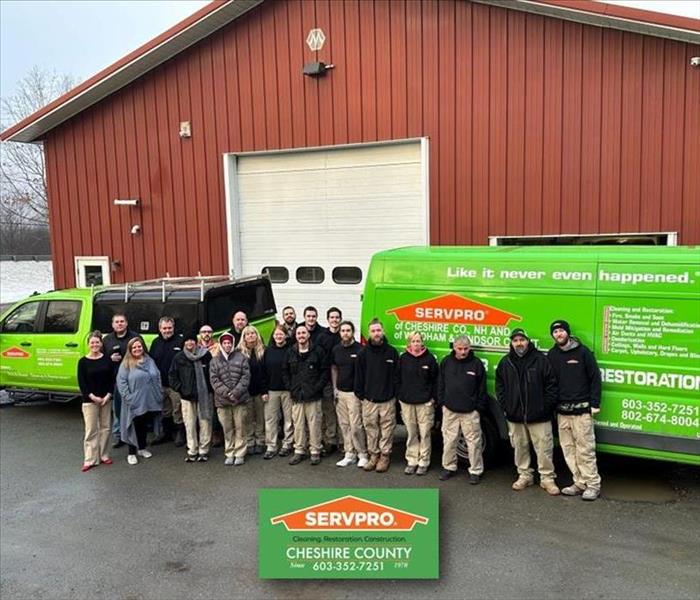 SERVPRO of Cheshire County: The team that is faster to any size disaster!
SERVPRO of Cheshire County: The team that is faster to any size disaster!
Winter in New England can bring a multitude of surprises and challenges when it comes to weather. Snow, slush, sleet, ice, and of course, frigid temperatures.
Last weekend, parts across New England experienced some of the most bone chilling temps in recent memory. Beginning Friday night and culminating into Saturday morning, temperatures reached negative digits. When the windchill was factored in, depending on the location, temperatures reached -20, -30, -40, and in some places even -50 degrees Fahrenheit. Now that is cold! On top of Mount Washington, the windchill pushed the temp to over -100 degrees. Incredible!
These frigid temps and high winds led to power outages and an extremely high quantity of frozen pipes throughout our team's coverage area. SERVPRO of Cheshire County received over 100 service calls due to burst pipes in the week following this extreme freeze event. Our team has been incredible with responding and providing service to as many of our customers as possible without sacrificing quality or professionalism. We want to extend a big thank you to our clients who have been patient and understanding during this event as we continue onward. Lastly, we want to give a heartfelt thank you to our dedicated crew for their hard work for the past week. We're grateful to have such an amazing team here at SERVPRO of Cheshire County!
Winter Weather: Is Your Home or Commercial Property Prepared?
1/23/2023 (Permalink)
 Winter weather can be potentially damaging to your home or commercial property. Is your property prepared this winter?
Winter weather can be potentially damaging to your home or commercial property. Is your property prepared this winter?
It's winter here in southwestern New Hampshire which means snowstorms, ice, and cold weather are upon us. Our homes and properties are susceptible to damage when winter weather arrives. As we like to do each year, here are a few reminders and suggestions to prepare your home or property during the cold months.
- Protect water pipes from freezing. Flow-based leak detection systems can shut down your home's water supply in the event of an emergency. Be sure to cover outside faucets as well.
- Keep thermostats at a reasonable level to adequately heat your property. As a recommendation, avoid dropping your thermostat below 65 degrees Fahrenheit.
- Backup generators are a great way to ensure key elements to your home can run in the event of a power outage. Furnaces and water heaters need power to run, not to mention the benefit of having light and the ability to use kitchen appliances.
- Adding insulation where needed, such as attics, cold and unheated basements, wall cavities, floors, basement windows, and around exposed pipes can greatly improve your property's ability to hold in heat and keep out the cold.
- Be sure that the area around windows is caulked thoroughly to reduce heat loss and to cut down on your heating costs.
- Clear rain gutters as often as possible. Specifically, be sure the downspouts are clear of debris to ensure proper drainage.
Be sure to monitor and inspect these areas of your home regularly this winter. The more often they are checked, the more likely a potential issue is discovered before it becomes a real problem.
Winter Storms: Protecting Your Property From Frozen Pipes
12/29/2022 (Permalink)
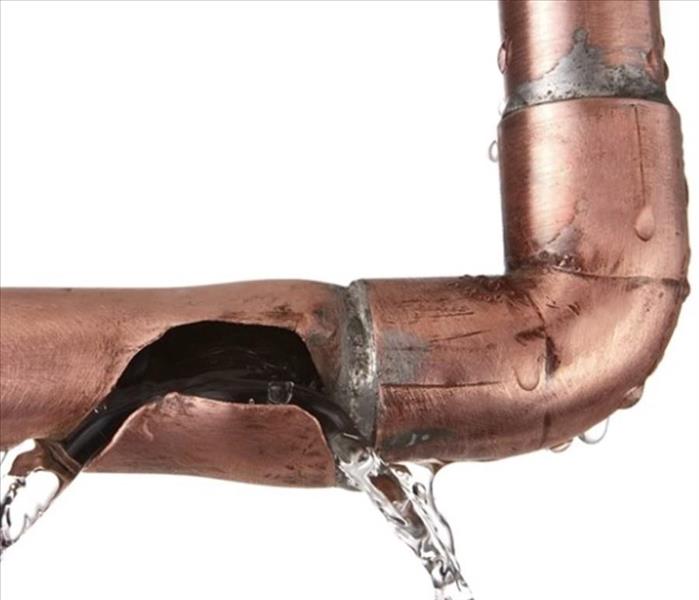 Keep these preventative measures in mind to help prevent frozen pipes.
Keep these preventative measures in mind to help prevent frozen pipes.
As 2022 draws to a close, and we're but a few days from January, winter is here and that means cold weather. Cold weather can mean a lot of things to a homeowner, business owner, or property manager, and right at the top of the list for property damage concerns are frozen pipes. Baseboard heat pipes, supply lines, sprinkler heads, and outdoor spickets are just a few areas where a frozen pipe can potentially create extensive damage to a property.
Even a small crack or puncture can lead to hundreds of gallons of water to infiltrate your building. The three common causes of frozen pipes are:
- Quick drops in temperature
- Poor insulation
- A thermostat that is set too low
Consider these preventative measures to help prevent frozen pipes in your property:
- Insulate your pipes. Exposed pipes are most susceptible to freezing.
- Seal leaks that allow cold air inside. Look for air leaks around the electrical wiring, dryer vents, and pipes and use caulk or insulation to keep the cold out.
- Let water drip. Let warm water drip from a faucet overnight.
Safety Considerations for the Winter Season
11/15/2022 (Permalink)
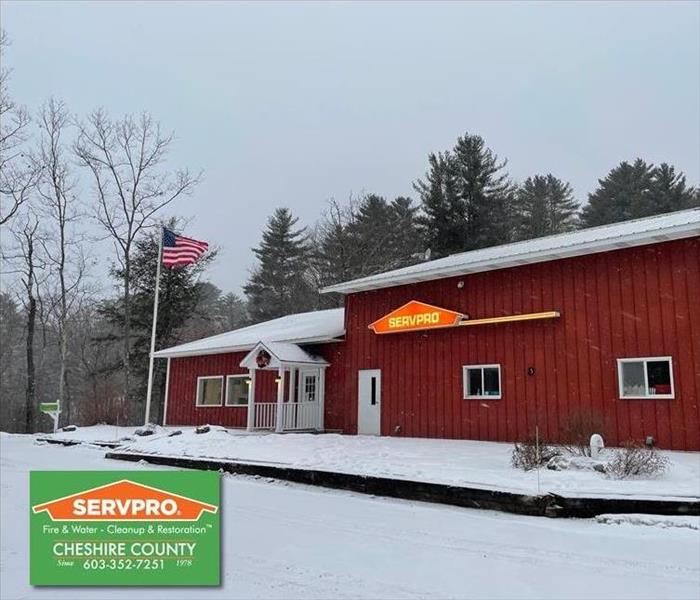 Winter is just around the corner! Are you ready?
Winter is just around the corner! Are you ready?
Living in New England, we have the privilege of experience the four seasons and all that comes with them. Changing weather, beautiful colors, the smells, the sounds, and the adventure. Although still in the fall, winter is just around the corner. Not too long from now we will be reacquainted with snow hats, gloves, shovels, snow blowers, salt, firewood, holiday decorations, ice skates, skis, and sleds. It's an exciting time that not everyone in the country can enjoy, but it can also be treacherous. Here are a few safety reminders for the upcoming winter season.
- Be prepared: stay informed of incoming snow and ice storms.
- Create an emergency kit.
- Check your smoke & Carbon monoxide alarms.
- Consider purchasing a generator to provide power during outages.
- Make sure your vehicle is winter storm ready with proper tires and make sure your gas tank is at least half-full.
- Minimize driving during winter storm events.
- Dress accordingly for the frigid weather.
- Watch for signs of hypothermia and frostbite.
- Be conscientious of your pet's well-being and safety in the cold weather.
- Clear exhaust vents from direct vent gas furnaces to avoid carbon monoxide poisoning.
- Dig out fire hydrants and storm drains in your neighborhood.
- Keep snow from accumulating on your roof to help prevent roof collapses and ice dams.
- Be sure to check on your neighbors, especially those that are elderly, have medical conditions, or those that live alone.
Be sure to take full advantage of the many joys of winter but prepare and be safe as well.
Hurricane Facts
11/12/2022 (Permalink)
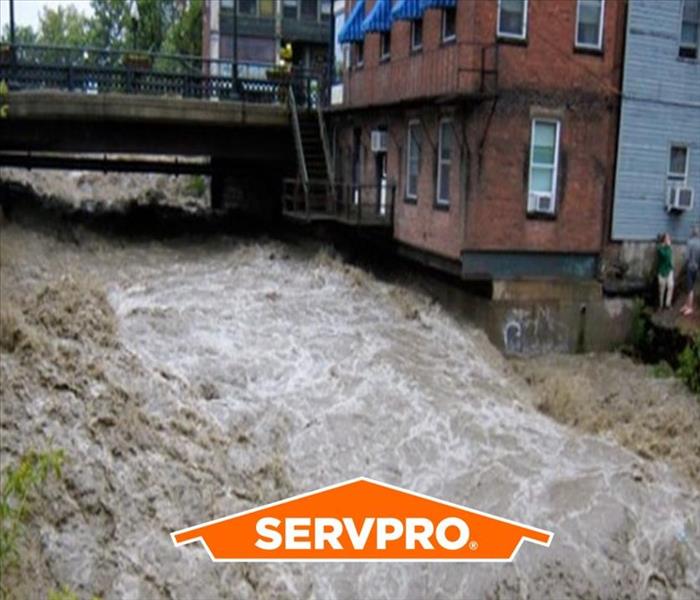 We're here to help 24/7 for storm cleanup and restoration.
We're here to help 24/7 for storm cleanup and restoration.
Although Hurricane Season is in its final weeks, you can't rule them out just yet. Hurricane Ian made landfall in late September/early October, and just this past week, Tropical Storm Nicole made its way into Florida and up the east coast. Hurricanes can be life-threatening as well as cause serious property damage from high winds, flooding, storm surge, landslides, and power outages. Preparation is paramount when protecting your property against potential damage from hurricanes. Plan an evacuation route, prepare an emergency kit, and take inventory of your property.
Here are some facts you may not be aware of regarding hurricanes:
- Roughly 40% of hurricanes hit Florida.
- 2004's Hurricane Ivan produced 127 tornadoes in nine different states over a ten-day period.
- To identify these storms, the World Meteorological Organization maintains a six-year rotating list of names.
SERVPRO of Cheshire County is available 24/7 to assist with emergency cleanup and restoration following hurricane and storm damage.
Hurricane Sandy: 10 Years Later
11/12/2022 (Permalink)
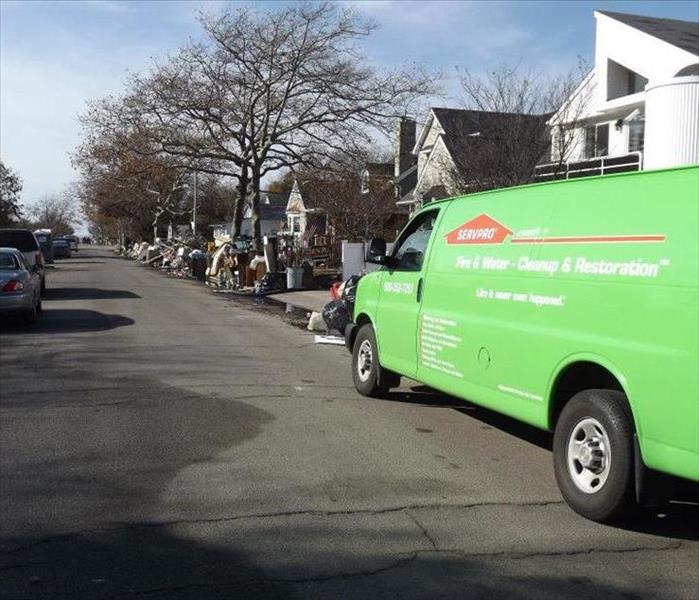 SERVPRO of Cheshire County was 1 of about 300 franchisees that mobilized to assist with Hurricane Sandy storm cleanup.
SERVPRO of Cheshire County was 1 of about 300 franchisees that mobilized to assist with Hurricane Sandy storm cleanup.
Back in late October of 2012, Hurricane Sandy (often referred to as "Superstorm" Sandy) landed on shore in just northeast of Atlantic City in New Jersey as a post-tropical cyclone with hurricane-force winds. Sandy affected 24 states, including all the eastern seaboard from as far south as Florida, and north to Maine. It reached as far west as Michigan and Wisconsin. The most severe of the damage took place in New Jersey and New York. New York City experienced flooded streets, subways, and tunnels. Sandy dissipated in early November, leaving in its wake, nearly $70 billion dollars in damage, and north of 200 deaths.
Nearly 1,000 SERVPRO crews, representing over 300 individual SERVPRO franchises, mobilized to storm affected areas all over the eastern part of the US to assist with flood damage. Our previous owner, Richard Paul, along with current Co-Owner, Ryan Paul, traveled south the Long Island, NY to assist a local SERVPRO franchise with a large influx of emergency service requests. Richard and Ryan brought with them a team of about a dozen technicians and project managers, several cargo trucks, a couple water extraction trucks, and about 100 pieces of drying equipment to help with emergency water mitigation caused by the storm.
The damage done by Hurricane Sandy was unforgettable and devastating. Our team did their very best to assist the Long Island, NY SERVPRO franchise in the 2+ weeks they were in town. The SERVPRO franchise system and Disaster Recovery Team are such incredible resources when tackling storm damage of this magnitude. One more reason why SERVPRO is the cleanup and restoration team that is "Faster to any size disaster."
Storm Damage: You Can Rely on SERVPRO
10/28/2022 (Permalink)
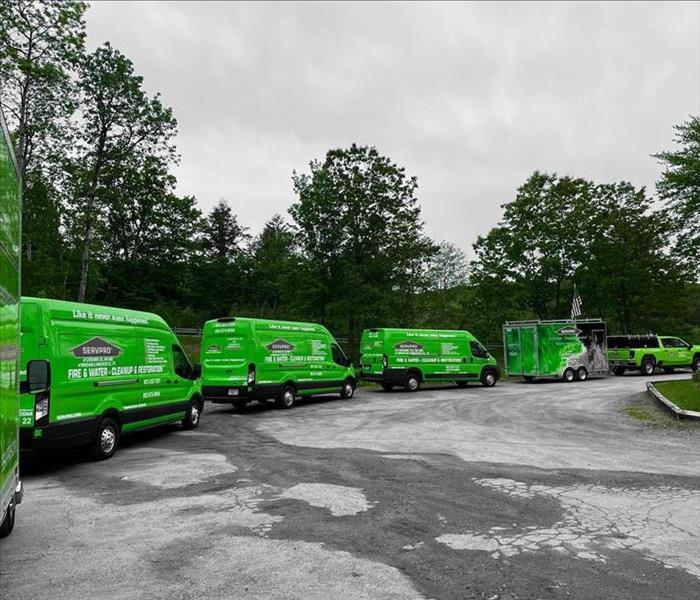 SERVPRO of Cheshire County: Faster to any size disaster.
SERVPRO of Cheshire County: Faster to any size disaster.
Storms can take many shapes and forms. They can differ in size, severity, and ferocity. One thing is consistent, storms are serious, often times frightening, dangerous, and damaging to your residential or commercial property. Heavy rains, lightning, rising waters, intense winds, hail, or snow, these elements can cause serious damage to a home or business.
SERVPRO of Cheshire County is a locally owned and operated franchise that has been serving the area since 1978. Timely response, professional service, and clear communication are three pillars our team considers in ensuring a positive customer experience.
Another major benefit to being a part of a franchise system when a major storm or catastrophe makes its way into our geographic area. When a major weather event strikes, we have the ability to contact and utilize franchises from around the country. With over 2,000 franchises nationwide, over 20,000 SERVPRO personnel, and the largest supply of owned restoration equipment, there is literally no job that is too big for SERVPRO to handle.
When it comes to storm damage, we mean it when we say SERVPRO is "Faster to any size disaster."
Storm Damage Comes in Many Forms
8/22/2022 (Permalink)
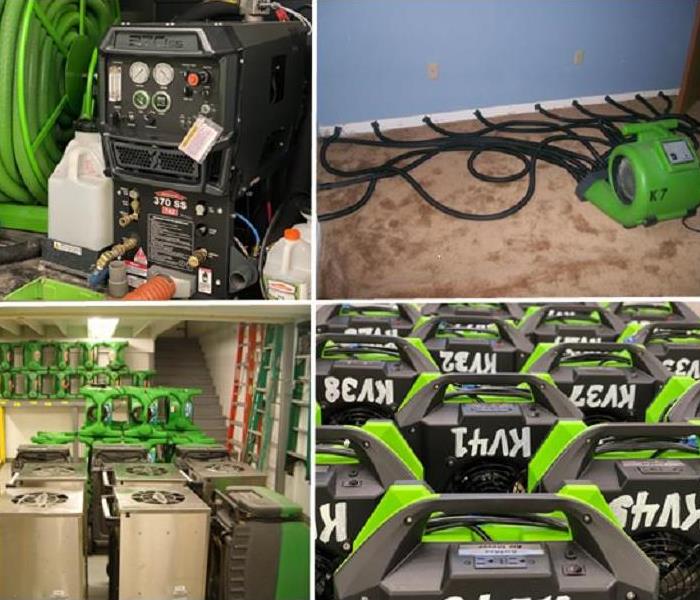 SERVPRO of Cheshire County has the necessary equipment to mitigate property-related storm damage of any size or severity.
SERVPRO of Cheshire County has the necessary equipment to mitigate property-related storm damage of any size or severity.
Depending on the season, especially here in Southwestern New Hampshire, storms can come in a variety of forms. They may differ based on many kinds of precipitation, temperature, severity, and intensity.
Most common during summer months, thunderstorms can bring with them strong winds, heavy rains, lightning, rising waters and often hail. When it comes to winter, storm damage varies even more. Substantial, accumulating snowfall, freezing rain, ice buildup, ice dams, periods of sub-freezing temperature are commonplace for New England Winters. In the Springtime, the combination of warming temps, snow melt, and the occasional rainfall can create flood concerns.
Each of these types of storm damage can be damaging to your home or commercial property. SERVPRO of Cheshire County is equipped the proper equipment needed and trained personnel to remedy storm-related damage to your property no matter the size or severity. SERVPRO of Cheshire County is available 24/7 to make storm damage "Like it never even happened."
Flood Water: Knowing the Terms
7/18/2022 (Permalink)
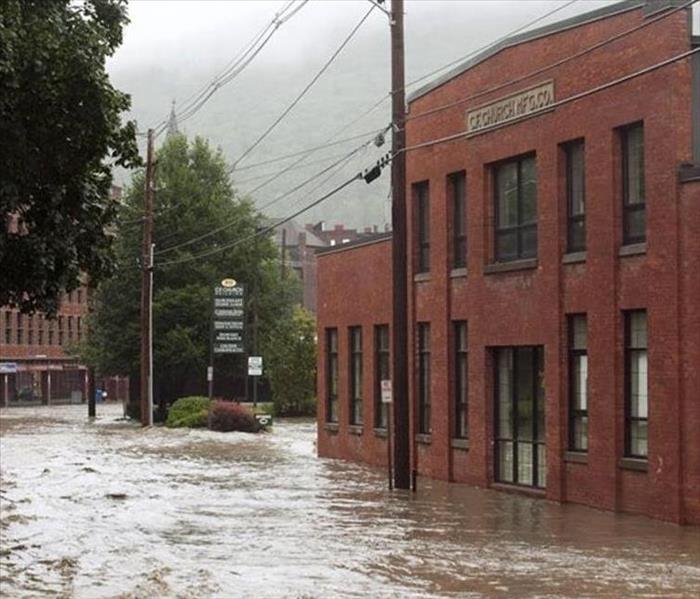 Being prepared can make a major difference when damaging rain and flooding make their way through your town and surrounding areas.
Being prepared can make a major difference when damaging rain and flooding make their way through your town and surrounding areas.
It was almost a year ago, the local area was inundated with heavy rains, downpours, and rising water. In July of 2021, we saw record rainfall in several of our surrounding towns. Rivers swelled, the ground became overly saturated, and as a result we received an abundance of service requests for flooded properties.
The heavy rains arrived unexpectedly for many. Preparation can be helpful in minimizing property damage but more importantly, for the safety of you and your family. Here are a few terms relating to flooding and their meanings which can be helpful before the onset of heavy rainfall.
Flood Watch: Flooding is possible. Listen to weather radio, commercial radio, or TV for information.
Flash Flood Watch: Flash flooding is possible. Be prepared to move to higher ground; listen to weather radio, commercial radio, or TV for information.
Flood Warnings: Flooding is occurring or will occur soon; if advised to evacuate, do so immediately.
Flash Flood Warnings: A flash flood is occurring; seek higher ground on foot immediately.
Remember to take as many safety precautions as possible prior to flood causing rains. If your property becomes damaged by flooding, contact the emergency restoration team that's faster to any sized disaster: SERVPRO of Cheshire County.
Lightning Safety Tips
5/16/2022 (Permalink)
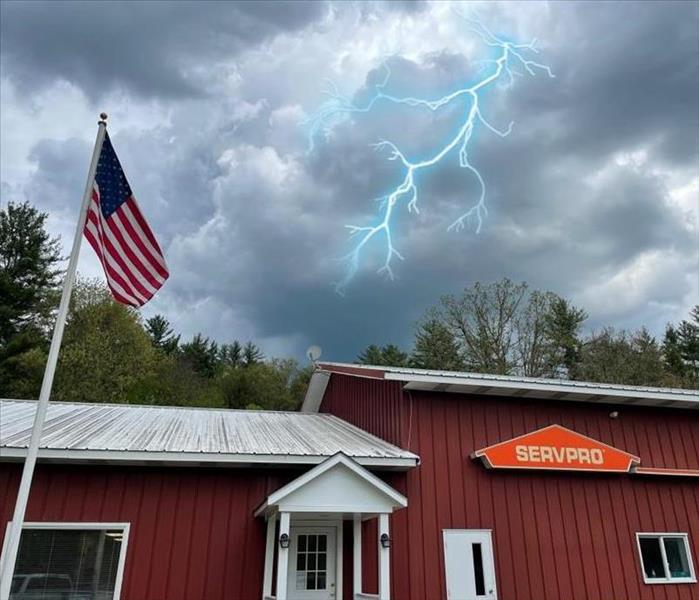 Thunder and lightning storms can be dangerous. Be sure to take proper precautions when confronted by a thunderstorm.
Thunder and lightning storms can be dangerous. Be sure to take proper precautions when confronted by a thunderstorm.
While technically still Spring, summerlike weather is just around the corner. Along with high temperatures and humidity, comes the threat of heavy rain, thunder and lightning. An afternoon thunderstorm during the summer can be refreshing and stimulating to the eye but can also be dangerous and potential harmful to your family or property. Here are a few pieces of info and pointers to keep in mind as we enter thunderstorm season.
- If you hear thunder, lightning is close enough to strike you.
- When thunder is heard, quickly move to a safe shelter.
- Stay in the safe shelter for at least 30 minutes after the storm has passed.
While indoors during a thunderstorm:
- Stay off corded phones, computers and other electrical equipment that could potentially put you in contact with electricity.
- Avoid Plumbing, including sinks, baths, and faucets.
- Stay away from windows and doors, stay off porches and decks.
- Do not lie on concrete floors and do not lean against concrete walls.
While outdoors during a thunderstorm:
- Avoid highly elevated areas such as mountains, hills or peaks.
- Do not lie flat on the ground.
- Do not shelter under an isolated tree.
- Avoid ponds, lakes, rivers and other bodies of water.
- Stay away from objects that conduct electricity such as power lines, windmills, barbed wire fences.
Be sure to consider these reminders the next time you experience a thunder and lightning storm. Be safe, be alert, take precautions.
Wind Damage Prevention
4/22/2022 (Permalink)
 Be sure to prepare for high winds prior to the event to protect your home or commercial property.
Be sure to prepare for high winds prior to the event to protect your home or commercial property.
It's Spring here in Southern New Hampshire. The weather is changing constantly. It can be difficult to predict. Warm temps, cold temps. Sunshine, then rain. Frosty mornings, comfy afternoons. However, one element that seems to be consistent is the wind. While wind can be a nuisance and add a chill to the air, it can also be potentially devastating to your residential or commercial property. Here are a few things to consider when protecting your property from strong winds:
- Trim trees or shrubs close to your home
- Remove debris from the yard (outdoor furniture, toys, etc.)
- Cover windows with plywood if sever winds or storms are approaching
- Ensure materials such as roofing are, fencing, chimneys are properly maintained
- Keep rain gutters clear and clean
Stay up to date with current weather forecasts and be sure to prepare for heavy winds prior to, rather than during the event.
Residential Ground Water Damage
4/22/2022 (Permalink)
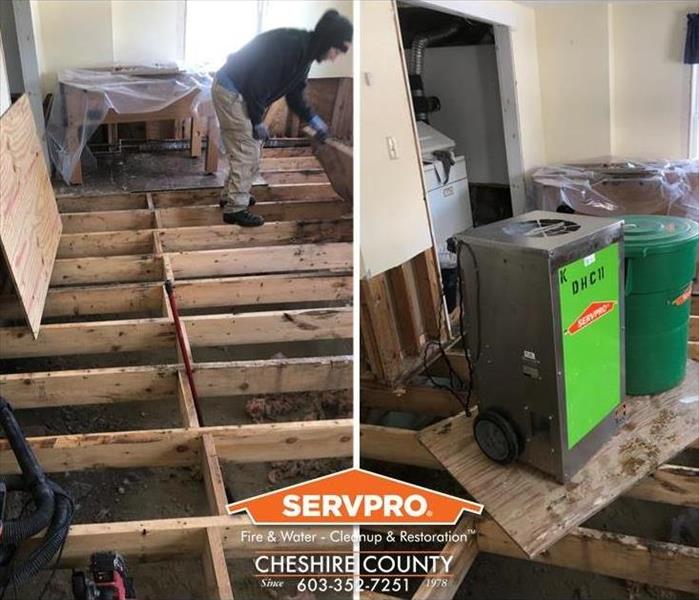 Water mitigation can often require several steps to ensure affected areas are properly dried.
Water mitigation can often require several steps to ensure affected areas are properly dried.
Due to recent rainfall, combined with snow melt and warmer temperatures, a number of service calls have come in for flooded basements. In many cases, old, cracked, or damaged foundations were overwhelmed by the high amounts of ground water at which point basement water intrusion occurs.
In a recent case, the water level at this residential property came up through the crawlspace, and flooded parts of the first level of the home. The water mitigation of the property was extensive. First, water was pumped and extracted from the crawlspace. Next, flooring and subfloors were removed from the first level, followed by 2-foot "flood cuts" to the base of sheetrock walls. Wet, damaged insulation from wall cavities was then discarded. Finally, open areas of the building structure were cleaned and dried using high powered air movers and dehumidifiers.
There were several steps and phases to this water mitigation project, but by the end, the affected areas were dried and ready for reconstruction.
Portable Generator Safety
2/25/2022 (Permalink)
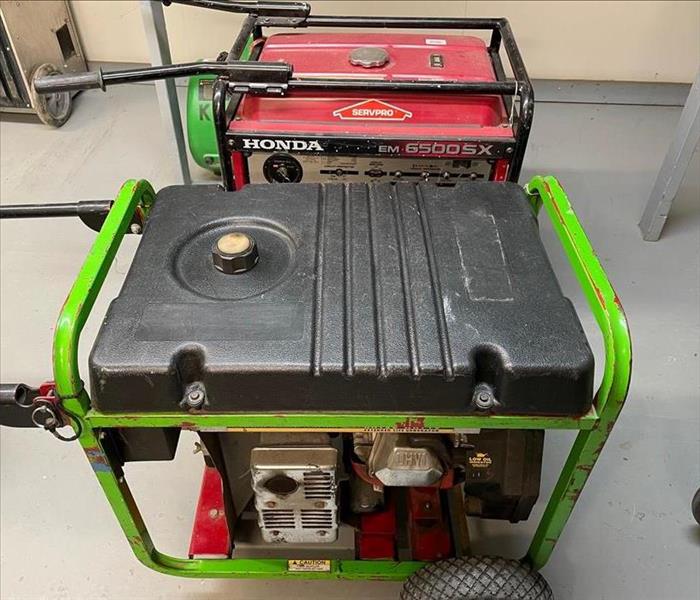 Portable generators are a great way to supply power temporarily but should be maintained regularly and used with caution.
Portable generators are a great way to supply power temporarily but should be maintained regularly and used with caution.
Spring is just around the corner but until then, snowstorms, ice, frigid temperatures, and heavy winds are to be expected. These weather characteristics are synonymous with power outages and loss of electricity. Having a portable generator can be a valuable commodity in these occasions. It is important however, to keep safety in mind when using them. Please consider these important tips when using your portable generator, courtesy of Energy.gov. For further details, tips, and clarification, be sure to check out the link above.
- Use your generator correctly. Using a generator incorrectly can be dangerous.
- Position generators outside and away from any structure.
- Keep your generator dry.
- Disconnect power coming into your home or business prior to operating your generator.
- Make sure generator is properly grounded before using.
- Plug equipment directly into generator.
- Never plug generator into a wall outlet.
- Maintain an adequate supply of fuel.
- Prior to refueling, allow the generator to cool down once turned off.
- Inspect, service and maintain generator regularly.
Generator safety and maintenance are crucial. Keep these tips in mind and you will be set to go the next time your generator is needed.
Information on Ice Dams
1/11/2022 (Permalink)
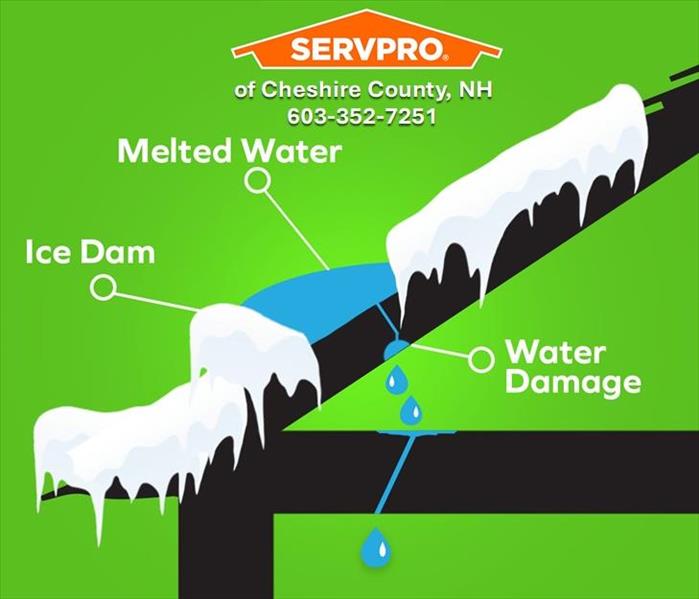 Ice dams can be managed, and steps can be taken to prevent their formation.
Ice dams can be managed, and steps can be taken to prevent their formation.
It's January, and we are sitting squarely in the middle of Winter. Here in New England, that can mean a long list of potential issues for your home. One common damage causing issue are ice dams. Ice dams form as a result of heat loss through the roof of a home. A ridge of ice that forms at the roof's edge and prevents water from draining creates the ice dam. Ice dams can become a nuisance to your property when water backs up behind the dam and works its way under shingles and begins to leak into the home. Insulation, walls, ceilings, and other areas can become affected. Water that is not dried quickly and thoroughly can eventually lead to mold growth.
Hot water can be used to melt the ice dam but do so gently. Heat cables can be installed on the roof prior to the winter and snow months. Raking your roof consistently around the edges following snowfall will help to prevent ice dams as well. Keep your gutters clean and downspouts clear to avoid slowly draining gutters which could potentially cause ice dams.
If an ice dam develops, do not use rock salt or sodium chloride to attempt to clear the ice dam. This material is highly corrosive and can cause damage to roofing, gutters & downspouts and siding. Deicer is better. A sock or pantyhose can be filled with deicer and placed vertically on the roof to break up the ice dam. The melted areas where the deicer was placed can allow drainage channels for the excess water.
Protect Your Home from Winter Weather
12/20/2021 (Permalink)
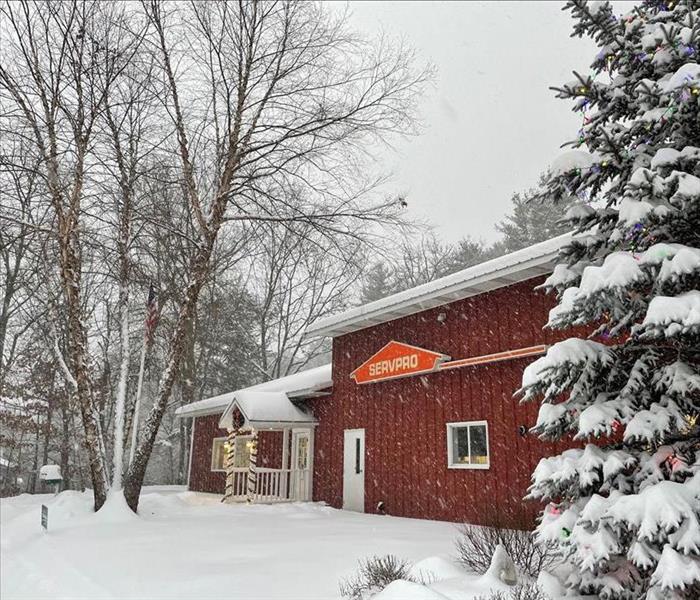 Prepare your home or commercial property to help prevent damage from the winter elements.
Prepare your home or commercial property to help prevent damage from the winter elements.
As we're on the eve of the official start of Winter, it's never too early to begin preparing for the elements and protecting your most prized possession, your home!
Here are a few friendly reminders and tips to help protect your home this winter:
- Insulate pipes in your crawlspace or basement. This will help prevent them from freezing and ultimately bursting.
- Clean your rain gutters. Keeping your gutters clean can help to prevent ice dams and cracking gutters.
- Trim branches aways from your roof. Heavy snow and ice could potentially weaken the branches and ultimately fall and damage the roof.
- Seal air leaks by caulking cracks around trim and windows. Use rubber or metal door sweeps between the bottom of doors and flooring to seal in warm air.
- Have a generator on hand in the event of power outages. Consult a licensed electrician for proper installation.
Keeping these tips in mind will help immensely in preparing your home for cold weather this winter season.
Here to Help: Storm Damage Restoration
11/26/2021 (Permalink)
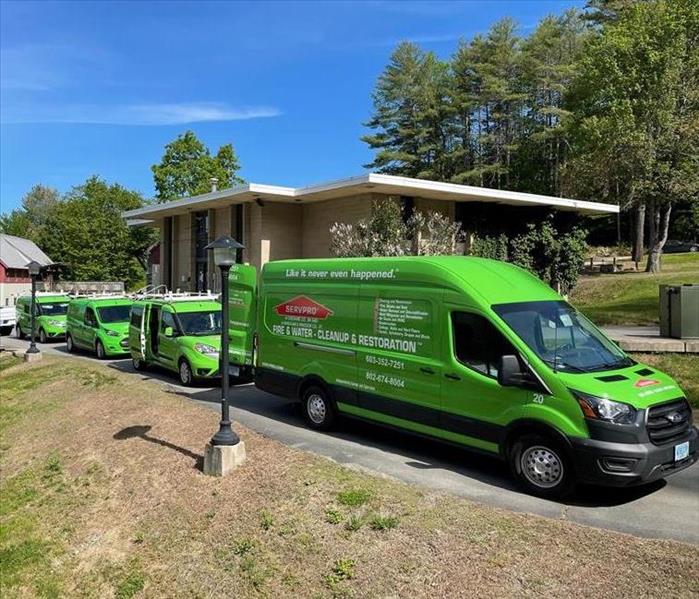 Contact SERVPRO of Cheshire County anytime: 24/7/365. Our team is faster to any sized disaster!
Contact SERVPRO of Cheshire County anytime: 24/7/365. Our team is faster to any sized disaster!
Storm damage can result from a variety of different types of events. Whether it be hurricanes, flooding, wildfires, tornadoes, or blizzards, the damage from nature's events can be severely damaging to your home or business.
SERVPRO of Cheshire County is available, equipped, and ready to assist when nature strikes. Our focus is, you, the customer. Specifically, we are here to help you get back into your home or business as quickly and safely as possible. No matter the size or severity of the damage you have experiences, SERVPRO of Cheshire County has the personnel and equipment availability to necessitate any size project. No job is too large, no job is too small.
From residential homes to commercial properties, large and small, SERVPRO of Cheshire County is here to help make storm damage "Like it never even happened."
Flood Damage Response
11/15/2021 (Permalink)
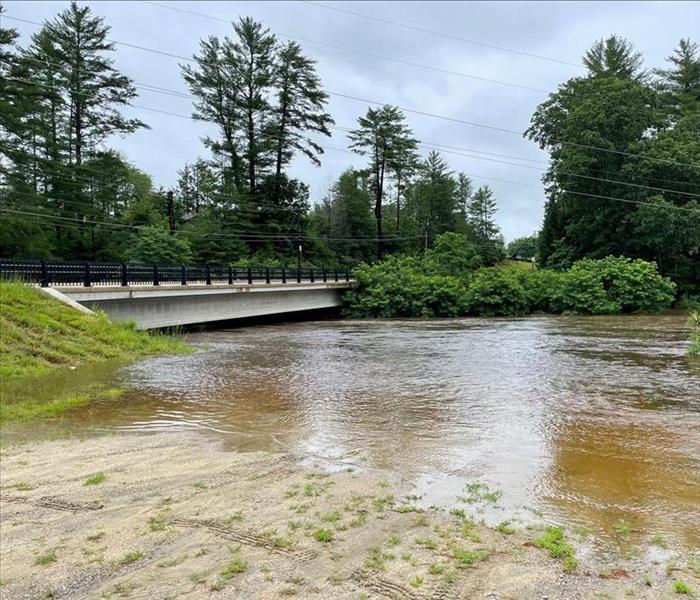 Throughout Southwestern New Hampshire, SERVPRO of Cheshire County is ready to assist with your flood damage.
Throughout Southwestern New Hampshire, SERVPRO of Cheshire County is ready to assist with your flood damage.
Floods can strike anywhere across the United States. The principal causes of floods in the eastern part of the US are hurricanes and storms. In the western part of the US, the principal cause of flooding is snowmelt and rainstorms. SERVPRO franchises across the country have assisted in flood and storm damage restoration for many major events such as Hurricane Katrina (2005), Hurricane Gustav (2008), Kentucky Floods (2009), Tennessee Floods (2010), Minot, North Dakota Floods (2011), Hurricane Michael (2018) to name a few.
SERVPRO of Cheshire County has been involved in several flood events over the years as well. In 2011, Hurricane Irene ravaged the entire state of Vermont and parts of New Hampshire. In 2012, our team assisted with local SERVPRO franchises in Long Island, New York following the devastating Superstorm Sandy. Most recently, parts of Southwestern New Hampshire were heavily affected by heavy rains this past July. In each of these local events, SERVPRO of Cheshire County was there to assist our neighbors.
Wherever your home or business may be located, there is a SERVPRO team ready to assist you and make flood damage "Like it never even happened."
Be Prepared: Flood Tips For Your Cheshire County Property
11/15/2021 (Permalink)
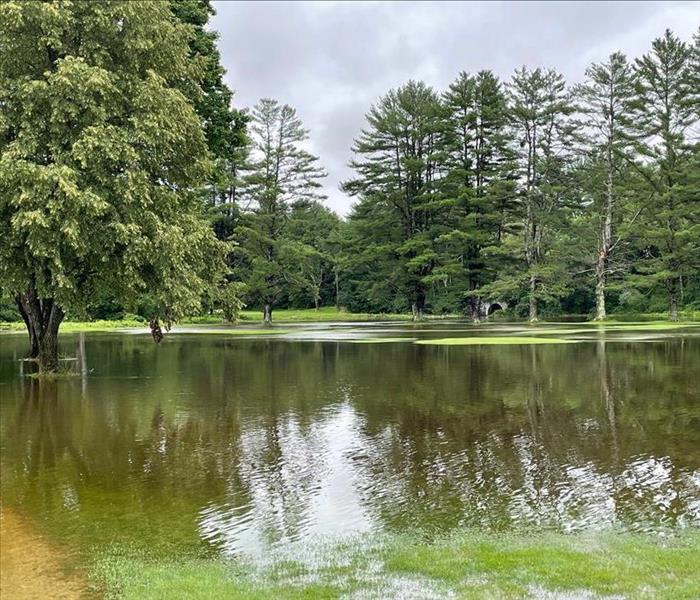 SERVPRO of Cheshire County is available 24/7 to assist with water damage. Don't wait, we're here to make flood damage "Like it never even happened."
SERVPRO of Cheshire County is available 24/7 to assist with water damage. Don't wait, we're here to make flood damage "Like it never even happened."
As we all know, it is much easier to prepare for a disaster before it occurs. Of course, we are all challenged with tasks, obligations and distractions in our everyday life which can prevent us from taking precautions following a disaster, in this case happens to be flooding. Below are helpful tips from Federal Emergency Management Agency (FEMA).
Before the Flood
- Have a qualified professional elevate your furnace, water heater and electrical panel if susceptible to flooding.
- Install "check valves" in sewer traps to prevent flood water from backing up into the drains of your home or business.
- Seal walls in basements with waterproofing compounds to help avoid seepage.
During the Flood
- Turn off utilities at the main switches or valves if instructed to do so.
- Disconnect electrical appliances.
- Do not touch electrical equipment if you are wet or standing in water.
- Do not walk-through moving water. Even six inches of moving water can make you fall.
After The Flood
- Listen for news reports to learn if the community's water supply is safe to drink.
- Avoid floodwaters. Water may be contaminated by oil, gasoline or raw sewage. Water may also be electrically charged.
- Stay out of any building if it is surrounded by floodwaters.
- Return home only when authorities indicate it is safe.
Once your property is deemed to be clear, contact SERVPRO of Cheshire County who are prepared to assist with flood damage restoration and water mitigation. We're here to help!
What's A Nor'Easter?
10/28/2021 (Permalink)
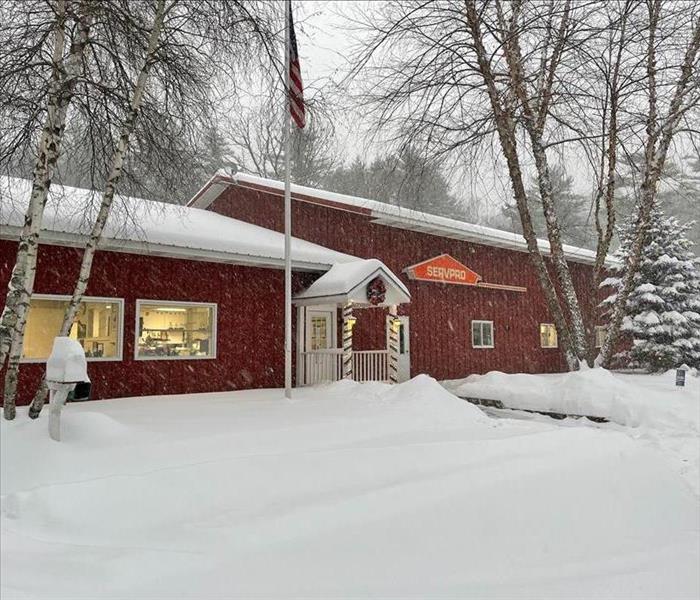 You can never be too prepared for treacherous winter weather. It's always easier to prepare before the weather arrives rather than during or after.
You can never be too prepared for treacherous winter weather. It's always easier to prepare before the weather arrives rather than during or after.
We may not want to admit it, but cold weather, snow and ice season is not far off the horizon. It's a good time to make sure you're snowblower is serviced, you've made arrangements with a snowplow driver, and you're stocked up on firewood for the Winter. It won't be long before the first snowstorm has made its way to our neck of the woods, or even more impactful, the arrival of the dreaded nor'easter!
These kinds of storms, which take place along the East Coast of the U.S., carry with them coastal winds that originate from the Northeast. Nor'easters can last anywhere from 24 to 36 hours and can produce wind speeds exceeding 58 miles per hour. A Nor'easter can take place any time over the calendar year but are most common between September and April. Nor'easters are large in diameter which can be 3 to 4 times larger than a hurricane. Heavy snow and blizzard conditions are also one of the prominent characteristics of a Nor'easter.
What was the worst Nor'easter you ask? In 1888, a storm which left a path of destruction from New England to Chesapeake Bay left 50 inches of snow in Massachusetts and Connecticut, 85 MPH winds, and sadly claimed over 400 lives, including about 100 that were out to sea. A Truly devastating storm indeed.
It's never too early to start preparing for the winter and the terrible weather that comes with it. Be prepared and be safe.
Record Rainfall for July 2021
8/9/2021 (Permalink)
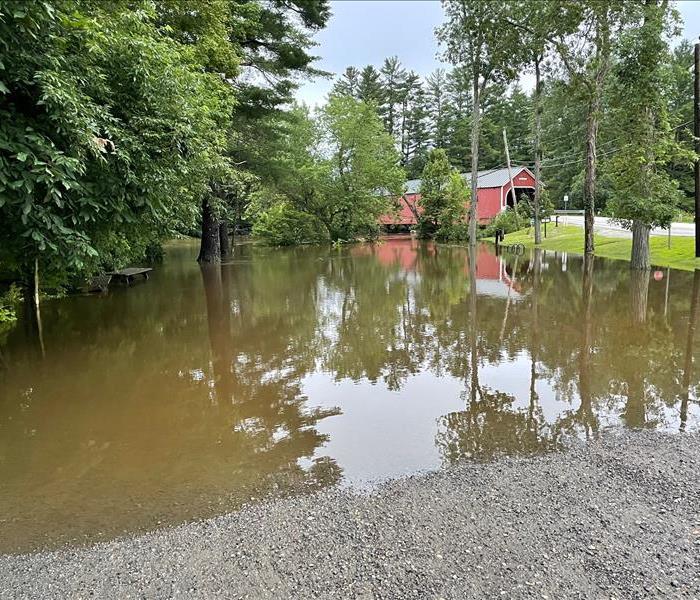 Record rainfall in the area led to the swelling of countless rivers, brooks and streams causing damage to local roads and property.
Record rainfall in the area led to the swelling of countless rivers, brooks and streams causing damage to local roads and property.
There's no doubt that Southern New Hampshire and Vermont have had their share of rain so far this Summer. Downpours, thunderstorms, driving rain, drizzle, more downpours, we've had it all and then some. Remnants from Tropical Storm Elsa also contributed large periods of rainfall.
July rainfall totals in Southwestern New Hampshire surpassed previous records that were set in the mid-1800s. Jaffrey, NH measured a record 19.17 inches of rainfall while Keene, NH saw an even 18 inches of rain. Swelling rivers, brooks and streams led to localized flooding throughout Southwestern, NH and Southern Vermont. SERVPRO of Cheshire County received hundreds of calls from property owners who experienced flooded basements, roof leaks and wind damage. Many homeowners expressed a common sentiment, "In all these years in our home, we've never had water in our basement." Very understandable as July was the rainiest for Southwestern NH in over 100 years. Areas in Southern Vermont were also affected and damaged by the high amount of rainfall.
If your home or business has experienced water damage resulting from flood water, or any water related mishap, contact SERVPRO of Cheshire County to make water and flood damage "Like it never even happened."
Facts About Microbursts
7/7/2021 (Permalink)
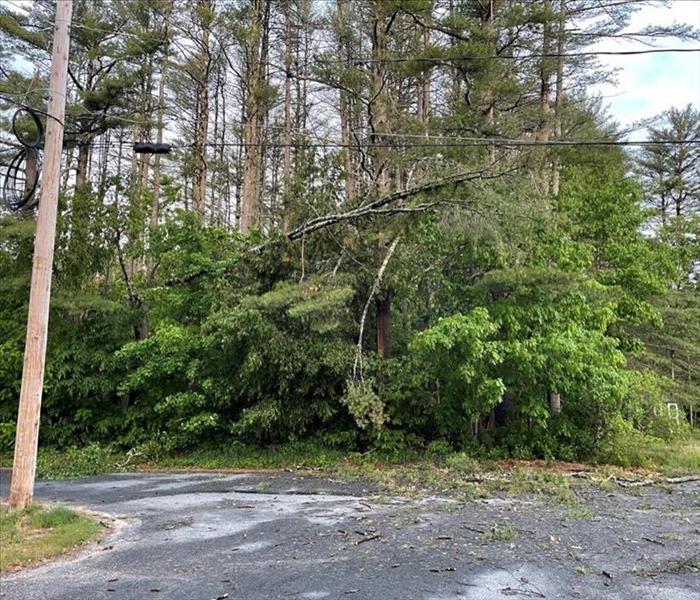 High winds can mean a dangerous environment causing tree limbs and branches to fall. Be sure to take necessary safety precautions.
High winds can mean a dangerous environment causing tree limbs and branches to fall. Be sure to take necessary safety precautions.
From heavy snow, freezing temps, and icy conditions in the winter, to high heat, hard rain and flooding in the summer, New England sees all kinds of treacherous weather. Another weather event that is not uncommon in the Northeast are what are called "microbursts."
- Microbursts are normally short in duration but are very intense.
- Microbursts occur when very high winds descend from rain clouds towards the ground and disperse horizontally.
- As previously mentioned, microbursts do not last long and typically pass after 10-15 minutes. Sometimes even shorter.
- A Microburst can cause damage, ordinarily, within a 1/2 mile- 2-mile diameter.
- Heavy winds are a characteristic most commonly associated with a microburst but can also include thunderstorms and heavy rain.
- Microbursts were only first observed in 1974 and the physics of them is still not completely understood.
- Microbursts are particularly threatening to airplanes, specifically during takeoff and landing.
Of course, with high winds comes the threat of down trees, limbs, and other airborne debris. Be sure to get to a safe area whenever a threat of a microburst arises.
Disaster Preparedness-Stay Protected
5/17/2021 (Permalink)
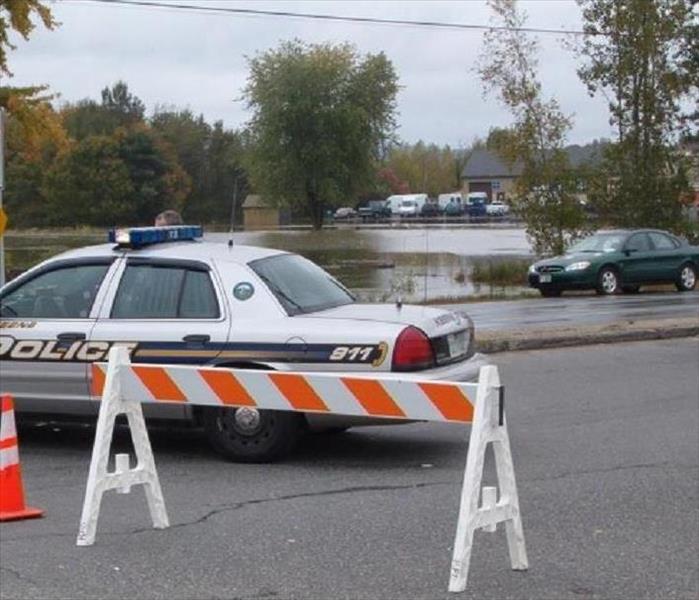 Preparing for natural disasters is the best way to ensure the safety of your family, business, and community.
Preparing for natural disasters is the best way to ensure the safety of your family, business, and community.
Next week is Disaster Preparedness Week and as natural disasters are increasing in severity and frequency, we thought it would be beneficial to outline some reminders to be more prepared for them.
Planning for events such as hurricanes, floods, snowstorms wildfires and even earthquakes help individuals and communities increase the health and safety during a disaster, protects the local tax base, ensures continuity of essential services, and supports a faster recovery in the aftermath of a disaster.
One of the best ways for communities to prepare for disasters is to build the most up-to-date, modern building codes. Disaster mitigation through the adoption and enforcement of building codes provides you, your family, and your community protection in the event of a natural disaster.
Making sure your family is prepared for any natural disaster is important. Your preparedness actions can ensure that no matter what Mother Nature brings, you, your family, and your community will be safe and resilient.
Flash Flood Preparedness
4/30/2021 (Permalink)
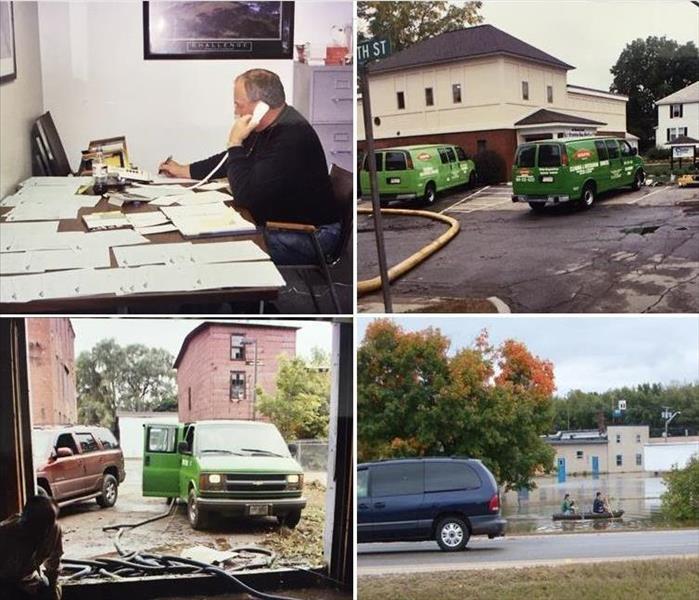 Flash floods can be dangerous and damaging. Contact the water mitigation professionals at SERVPRO of Cheshire County to assist with your property.
Flash floods can be dangerous and damaging. Contact the water mitigation professionals at SERVPRO of Cheshire County to assist with your property.
Here in Cheshire County, we are no stranger to foul weather. Whether it be snow, sleet, high winds, driving rain, thunderstorms, frigid temps, and even high heat and humidity, we get a little bit of everything. Often, we are faced with combatting flash floods.
Flash floods are caused by excessive rainfall, a dam or levee breaking or failing, or an ongoing ice jam loosening in the winter. Flash floods can be very damaging. Trees can be torn down, large boulders moved or rolled, and even buildings can be damaged, and in some cases, destroyed. You want to take certain precautions any time there is a potential for a flash flood. Here are a few tips to keep in mind.
- Be alert and aware of a possible flash flood.
- Review your family disaster plan.
- Create a disaster emergency kit.
- Stay off roads unless absolutely necessary.
- Do NOT drive through flooded roadways.
- Move any personal belongings on your property to higher ground.
- Take into consideration the safety of family members, loved ones and pets. Have a safe place to relocate to.
- Disconnect appliances and electrical items in low levels of property.
- Seal vents/windows to your basement.
The best thing you can do prior to flash flooding is be prepared. Be aware and listen for warmings and inclement weather forecasts. Be safe and plan ahead of time. Once the weather subsides, SERVPRO of Cheshire County is ready to provide you with the water mitigation your property may need!
High Wind Safety
4/28/2021 (Permalink)
 High winds can be potentially dangerous and its beneficial to be prepared when extreme weather approaches.
High winds can be potentially dangerous and its beneficial to be prepared when extreme weather approaches.
You may have noticed; Cheshire County and the neighboring areas have experienced weather with very high winds as of late. The windy days seem much more frequent than the calm ones. Great kite flying weather, not so great for keeping the yard cleaned. More importantly, high winds can be potentially dangerous. Here are a few safety pointers to consider when experiencing high winds.
- Evacuate manufactured homes.
- Take shelter in a safe location.
- Keep a disaster kit easily accessible.
- Items outside the home such as patio furniture, kid’s toys, garbage cans should be put inside a garage or the home.
- Remove or trim potentially dangerous tree limbs before the storm arrives.
- In extreme wind conditions, board of glass windows and doors
- Having a generator for extreme wind events is a good strategy due to the high likelihood of power loss.
Keep these tips and pointers in mind before the next high wind weather event in your area!
Storm Prep: Build a Disaster Supply Kit
2/16/2021 (Permalink)
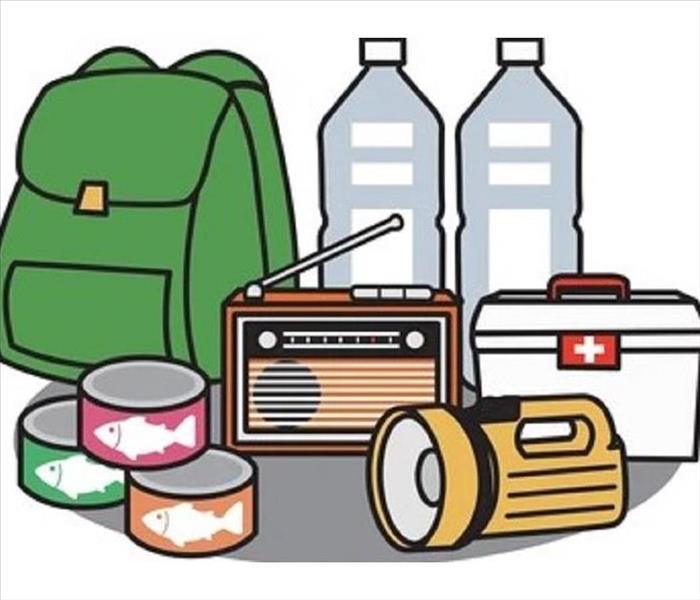 Building a Disaster Supply Kit with items you will need following a storm is key for optimum preparedness.
Building a Disaster Supply Kit with items you will need following a storm is key for optimum preparedness.
When it comes to combating oncoming storms, the best offense is a good defense. In other words, being prepared for storm damage is of the utmost importance. Whether it be a snow, ice, rain or windstorm, having a plan in place and a disaster supply kit assembled, will have you one step ahead when they strike. Here are a few recommendations for your Disaster Supply Kit:
- Water (one gallon per person per day for a minimum of 3 days)
- Food (no less than a three-day supply)
- Battery powered radio
- Flashlight
- First aid kit
- Additional batteries
- Cell phone with chargers/battery backup
- Toolbox
- Pet food (if there are pets in the household)
- fire extinguisher
- Change of clothing for the appropriate weather and sturdy shoes
- Matches (preferably in a waterproof container)
- Writing utensil and paper
- Feminine supplies and personal hygiene items
- Paper towels, plates, cups, and plastic eating utensils.
Other tasks that should be kept in mind prior to a storm:
- Fill your vehicle's gas tank
- Check your vehicle's tires
- Have cash on hand
- Charge your phone
- Plan alternate evacuation routes if necessary
- Gather important documents in a waterproof bag
- Have an extra set of keys
- Move your valuables to the highest level of the home
These are but a few items and tasks that can help you better be prepared when a storm is on its way. Of course, safety is of the utmost importance and should be your top priority. If your home or commercial property experiences fire, water, smoke or mold relating from storm damage, be sure to contact SERVPRO of Cheshire County and we'll be there to assist you. Always here to help!
Winter Storm Reminders
1/11/2021 (Permalink)
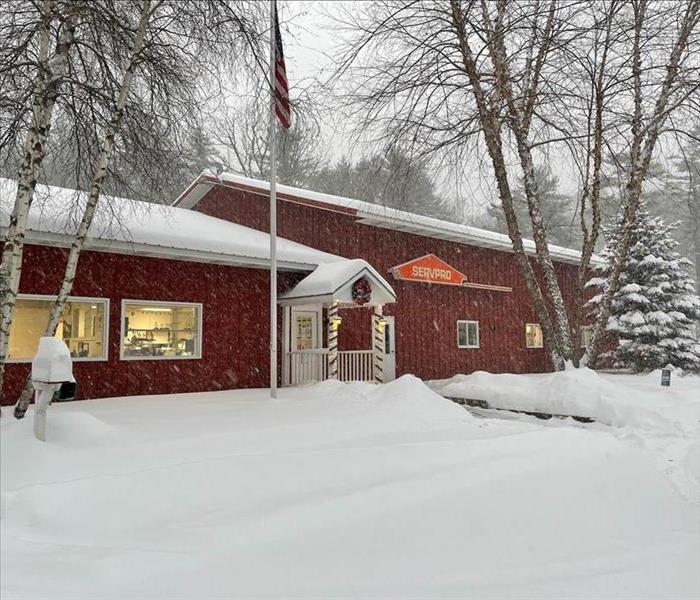 Winter is here. Be sure to have your home, business and vehicle prepared for the cold and snowy months ahead!
Winter is here. Be sure to have your home, business and vehicle prepared for the cold and snowy months ahead!
Winter has arrived here in the Southwestern New Hampshire and with it we have the arrival of heavy amounts of snow, freezing temps and potentially treacherous driving conditions. It's important to be prepared for these types of conditions specifically when it comes to your home and your vehicle. Here are a few reminders for the winter ahead.
- Prepare an emergency car kit: cell phone, phone charger, batteries, hats, coats, mittens, window scraper, shovel, water and snacks, and jumper cables.
- Stay off roads unless absolutely necessary.
- If you must drive, remember to leave plenty of space between your vehicle and the vehicle in front of you.
- Prepare for power outages.
- Service and maintain generators.
- Rake snow from the edge of roofs to avoid possible ice damming.
- Insulate exposed or vulnerable water lines in your home.
- Repair roof leaks.
- Caulk and weather strip windows and doors.
- Prune tree branches that could potentially damage your property during a winter storm.
- Keep a stocked first aid kit easily accessible.
- Have your home's furnace checked and serviced yearly by an HVAC specialist to ensure it is working as it should.
- Have your chimney or flue inspected by each year by an experienced inspector.
Remember these pointers as we batten down the hatches for a long, cold New England Winter. If your property experiences a fire, smoke or water emergency, please contact the professionals hear at SERVPRO of Cheshire County and we'll be happy to assist you. We're available 24/7/365 to make your emergency "Like it never even happened."
Ice Dams: Dreaded Winter Hazard
12/1/2020 (Permalink)
 Be sure to clear snow buildup around the edge of roofs to reduce the possibility of ice buildup.
Be sure to clear snow buildup around the edge of roofs to reduce the possibility of ice buildup.
Happy Holidays! It a very festive time of year but along with the holidays comes freezing cold temps, snow storms, sleet and ice. The elements can certainly make the short days seem long and can also pose serious threat to your home or property. Ice dams are one of these winter storm concerns.
Ice dams build up on the eaves of sloped roofs in buildings that are heated. Melting snow, stemming from heat loss in the building, causes snow to melt and run down to the edge of the roof where the surface is below freezing, and ice begins to build. That ice buildup can cause damage to rain gutters, shingles and eventually the interior of the house. Here are a few tips on how to combat the forming of ice dams on your property.
- Ventilate Eaves and Ridge Vents
- Vent exhausts from kitchen ducts, bathroom and clothes dryer are properly vented outside rather than into the attic
- Add insulation to the attic
- Seal and insulate air ducts
- Add steel flashing around the chimney
- Caulk around vent pipes and electrical cables with a fire-stop sealant
- Use roof rake to clear excess snow from the edge of roofs
Winter Storm Worries
11/25/2020 (Permalink)
 Snow storms are inevitable in New England and being prepared for the snow and freezing temps is a must.
Snow storms are inevitable in New England and being prepared for the snow and freezing temps is a must.
Winter weather can bring more issues than the common slippery roads and snow covered sidewalks. If you live in a part of the country such as New England, temperatures dropping below freezing in the winter comes with the territory. With freezing temperatures comes the possibility of freezing pipes which can result in significant water damage to your home or commercial property.
Frozen pipes occur when exposed to freezing temps such as outside your home, or in basements, attics, garages, crawlspaces, or along exterior walls. A frozen pipe can burst at the point where the ice blockage inside the pipe is located, but usually the rupture is caused from the backflow of pressure between the water source and the blockage.
If your home or commercial property experiences a burst pipe caused by the extreme cold temps that surround a winter storm, be sure to contact SERVPRO of Cheshire County to professionally assist with water mitigation. Our team will be sure to thoroughly dry and clean the affected areas to make it "Like it never even happened."
Flood Facts
11/17/2020 (Permalink)
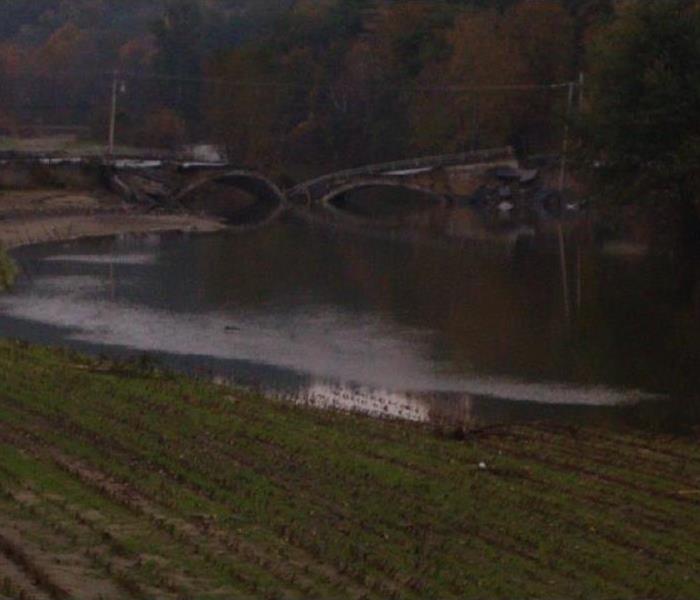 Rising river waters become incredibly destructive when they crest their banks. Buildings, trees, and even bridges are no match for their power.
Rising river waters become incredibly destructive when they crest their banks. Buildings, trees, and even bridges are no match for their power.
Floods are one of the most common and widespread natural disasters in the United States. No matter where you may live, floods can can pose a significant threat. Whether you are near mountains, coastlines, along city streets or near a river, the threat for flooding is all around us. According to the National Flood Insurance Program, houses in the United States 26% chance of being damaged by a flood during the course of a 30-year mortgage. Businesses face similar risks by flooding. Here are some statistics regarding flood damage in the US:
- More than half of all fatalities during floods are auto related often the result of drivers misjudging the depth of water on a road and being swept away in a swiftly moving current.
- Underpasses can be some of the most dangerous places during a flash flood- especially at night when it's difficult to see.
- The principal causes of floods in the western U.S. are snowmelt and rainstorms.
- The principal causes of floods in the eastern U.S. are hurricanes and storms.
- Floods kill an average of 140 people per year in the U.S., making flooding the most deadly natural disaster.
If a flood strikes your home or business, be sure to contact SERVPRO of Cheshire County. By doing so, you can trust that you've contacted a company with decades of experience in the industry who uses cutting edge equipment and has highly trained personnel to assist with your property damage. SERVPRO will stop at nothing to make your flood damage "Like it never even happened." Available 24/7/365.
Tips for Filing a Storm Damage Claim
10/27/2020 (Permalink)
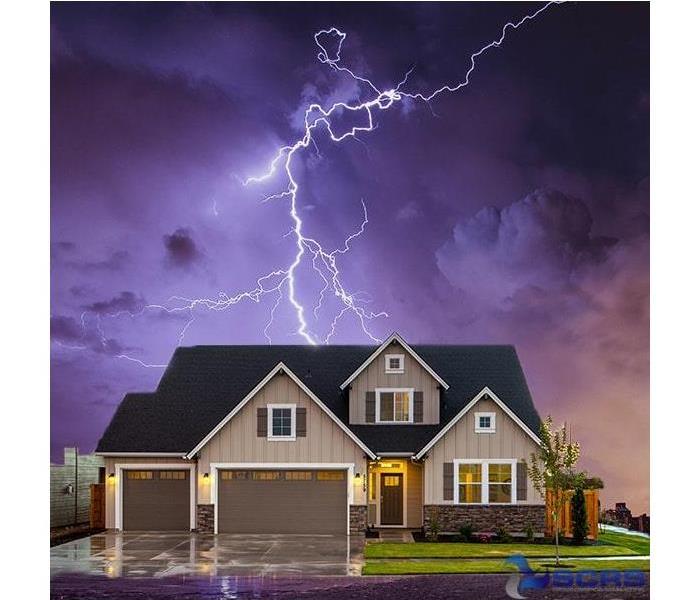 Severe storms can cause significant damage to homes, such as flooding. Make sure you are prepared with these helpful tips!
Severe storms can cause significant damage to homes, such as flooding. Make sure you are prepared with these helpful tips!
Severe storms can cause significant damage to homes, such as flooding. One purpose of a homeowners insurance policy is to provide coverage for disaster recovery following a major weather event. If you need to make a claim after poor weather impacts your property, here are some tips to make the process as smooth as possible.
1. Contact Your Provider
First, notify your insurance company right away. Some providers only have a narrow window during which a claim can be filed after damage occurs, so it’s essential to act quickly. Plus, this will allow you to get a claim number immediately, which may expedite repairs.
2. Document Losses
Before starting the cleanup process, document the damage to your home and property. Take photos and consider jotting down notes about items that have been damaged. For example, if you have electronics that have become waterlogged or damaged by a power surge, this won’t show up in photos, but you’ll still want to notify the insurance company.
3. Record All Claim Details
Every time you communicate with the insurance company, write down the time, date, and the person with whom you spoke. This log may be important should there be any disputes about your payout.
Plus, it will help you keep track of the status of your claim. Some companies offer text alerts so that you can easily be notified about updates as the claim is processed.
4. Gather Quotes
Next, reach out to a disaster recovery company to get an estimate for the cost of repairs or remediation services. Keep in mind that your insurance company may have requirements in place for this process.
For instance, you may have to go with approved service teams. Review your policy to determine the necessary steps.
5. Prevent Further Damage
In some cases, a disaster recovery team may be able to promptly address issues, like water damage. Yet, if you have to wait for certain services, such as roof repairs, you can prevent more damage from occurring with some preventive steps.
For instance, tarping a damaged roof can keep more moisture out. You’ll also want to promptly remove any furniture from flooded areas and get rid of any water that you can before help arrives, as long as the area can be navigated safely.
5 Steps to Take If Your House Floods
8/13/2020 (Permalink)
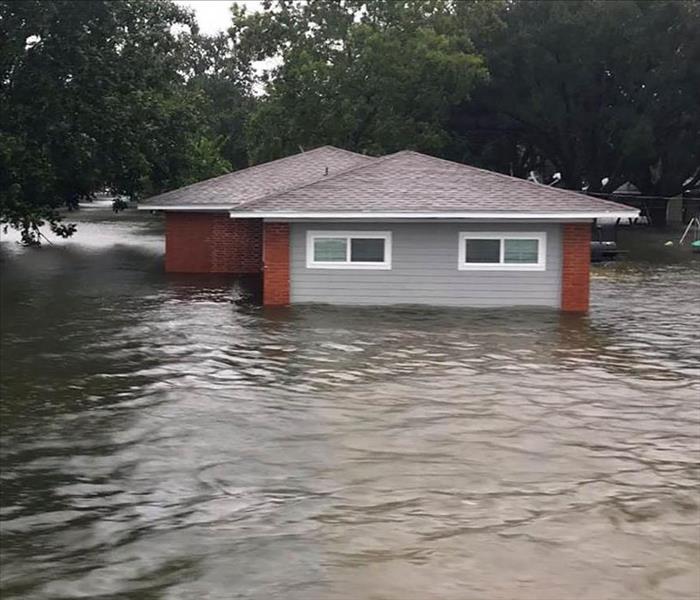 Severe weather and flooding can cause serious damage to your home.
Severe weather and flooding can cause serious damage to your home.
Whether due to extreme weather/flooding or a plumbing failure, a flooded house is a serious issue that can have repercussions long after the water recedes. Your first priority during a flood is to get your family to safety, but once the immediate emergency needs are taken care of, it’s time to focus on disaster recovery for your property. To protect your health and safety, below are the first steps to take.
How to Respond to a Flood in Your Home
1. Reduce Additional Risks
Electricity can cause additional dangers when your home floods. Even if the power has gone out, if there’s standing water in your home, you might be at risk for electrocution or fire when the power is restored. If you can safely reach the fusebox and turn off the main power line, then do so. If not, call an electrician for help. If it’s only your home that’s flooded, call the gas and sewer companies as well to shut off those lines to prevent more damage.
2. Avoid Contact With the Water
Even if the floodwaters appear clean, they could be contaminated with bacteria, sewage, or household chemicals that can make you sick. If you must enter your home for cleanup, use proper protective gear, including boots, hip waders, gloves, and masks. Take care when handling any items that have come in contact with the water, and throw away all food that got wet.
3. Take Photos
Before attempting to clean up or make repairs, take photos of the flood and damage. Your insurance company will need them to process your claim, and if you start cleanup before documenting the damage, you could affect your coverage and reimbursements.
4. Contact Your Insurance Company
Notifying your insurer as soon as possible after the flood can help speed your claim and get you on the road to disaster recovery sooner. Follow your insurer’s instructions regarding cleanup or repairs. They may request that you wait until an adjuster examines the damage before starting cleanup. If you are located in a designated disaster area, you may be eligible for additional help and funds from FEMA. Your insurance company will help you with that claim.
5. Begin Cleanup & Mitigation
Once your insurer gives the go-ahead, you can begin the process of disaster recovery. Because mold can begin to grow within 24 to 48 hours of a flood, it’s best to get professional assistance with cleanup. Without proper mitigation, floods can lead to toxic mold throughout your home, causing significant health risks. Expect to replace any furniture that was saturated, as well as carpeting and drywall.
Preparing For An Unexpected Hailstorm
7/9/2020 (Permalink)
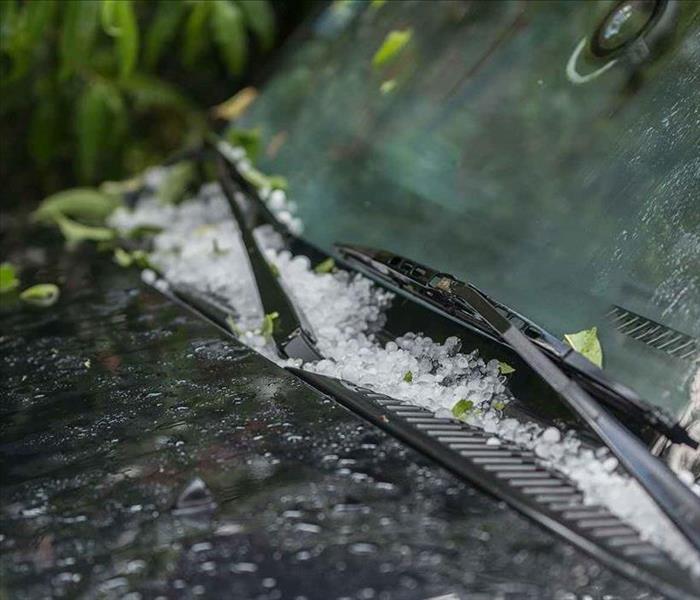 Hail can cause severe damage to your car or roof.
Hail can cause severe damage to your car or roof.
Hailstorms can happen year-round and can vary greatly in severity. Hail can be anywhere from .2 inches to 6 inches in size and weigh more than 1 pound. Annually, hailstorms cause close to $1 billion in damages mainly to roofs and cars. While hailstorms are not easily predicted, there are a few ways to prepare for them to lessen future damage. The first thing to check is your roof. You will want to look for any missing or worn shingles and get those replaced. If you know hail is on the way, try and get your car to the garage or a covered area if possible. Hail can be the bigger than a baseball and can fall from the sky up to 100 mph, yikes! During a hailstorm, you will want to stay inside and avoid skylights or any other glass windows/doors in your home. If you haven’t yet, check with your insurance carrier to see what is covered on your current policy and consider adding hail damage.
Preparing for Heavy Rain
5/18/2020 (Permalink)
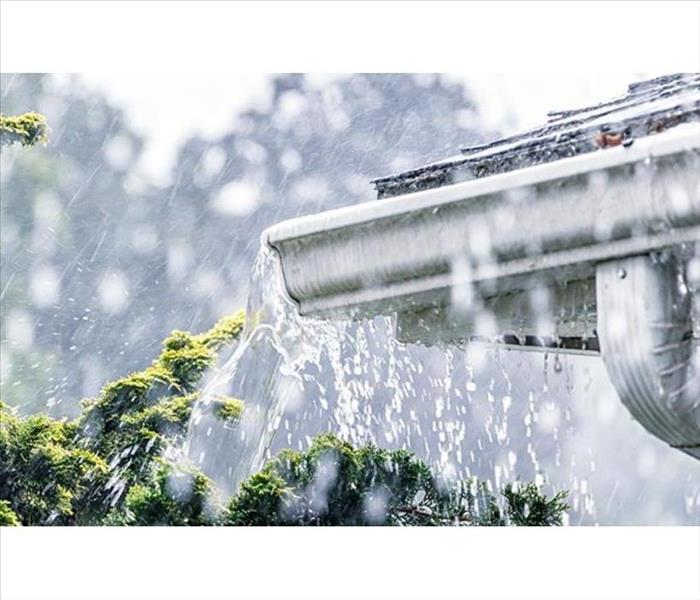 Heavy rain storms can cause serious damage to your property, be prepared!
Heavy rain storms can cause serious damage to your property, be prepared!
When a heavy rainstorm is on the horizon, the first thing to do is to check the outside of your home and make sure it is protected. Start by inspecting your roof for any areas that may be missing shingles, or aging/sagging. Clogged gutters can cause issues if they overflow, so check to see if your gutters are fully intact and clear them of any leaves or debris that may be piled up. While walking around your house, check to see that all windows and doors are closed, and that all lawn equipment is stored inside. Once the storm hits, plan on staying inside and avoid driving anywhere unless completely necessary. While checking weather reports, be sure to stay away from windows and doors as they can break or blow in if the wind is strong enough. Once the storm has passed, you should survey your property to check for any damage from fallen branches or to see if any power lines. It is very important to not touch any power lines that are down, and call professionals to repair it.
Generator Safety
5/1/2020 (Permalink)
Generators are helpful to have on hand, especially in the event of a power outage during a storm. For those new to using generators or feeling rushed to get the power on during a storm, it is especially important to slow down and ensure proper use of the generator. Using a generator incorrectly is dangerous. Below are steps from the American Red Cross regarding safe handling of a generator:
- Keep your generator dry and do not use in wet conditions (i.e. a flood) to avoid risk of electrocution. Have it running on a dry, flat surface under a shelter such as a canopy-like structure (i.e. a tarp supported by poles). Do not touch the generator if your hands are wet.
- Never use a generator inside your home, basement, garage, crawlspace or any partially enclosed area. This rule also applies to any camp stoves, grills, or other propane, natural gas, charcoal or gasoline-burning equipment.
- Turning on a fan or opening a door or window won’t prevent carbon dioxide (CO) buildup in your home. CO can’t be seen or smelled so it is crucial to avoid and be aware of the signs of exposure when operating a generator. If you begin to feel unwell, dizzy, nauseated or weak while using a generator, get to fresh air immediately.
- CO alarms should be installed on every level in your home in central locations as well as outside sleeping areas. The alarms will provide early warning signs of rising CO levels.
For these and other tips and information regarding health and safety, visit redcross.org
Helpful Tips During Severe Wind
4/22/2020 (Permalink)
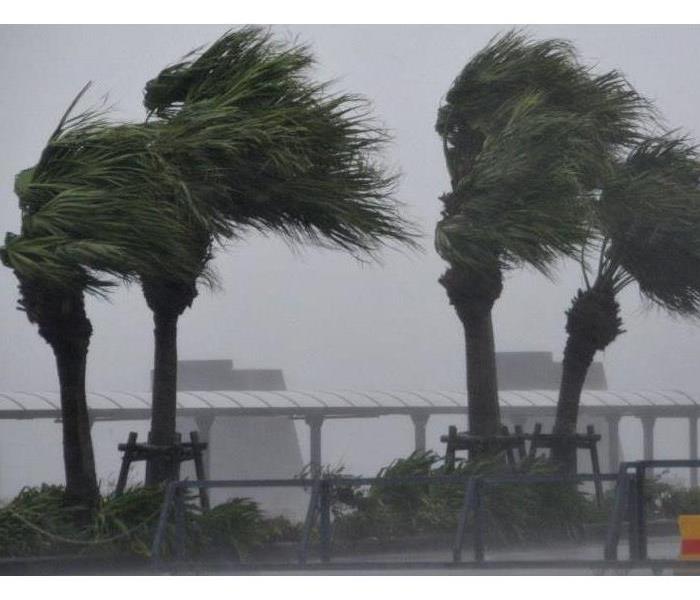 Palm trees during a severe wind storm.
Palm trees during a severe wind storm.
Preparedness is a very important when it comes to protecting your family & property from any severe weather or storm. Winds can reach up to more than 100 miles per hour during severe weather such as a tornado, but a high wind advisory is issued when winds of over 25 miles per hour are predicted. The first thing you will want to do during severe winds is find shelter and move towards the middle of your home or the basement if that is an option. Try to avoid being near any windows or glass doors, and bring belongings such as a grill, garbage cans, and patio furniture inside as these are wind-borne objects that could cause more damage to your home. Severe wind can happen anywhere, regardless of where you live so being informed on how to be prepared is important.
In the case of an evacuation, go to the nearest shelter if possible and follow these helpful tips:
- Lock all doors and windows at your home before you go.
- Bring a survival kit and other supplies such as food & water.
- Let family & friends know where you plan to be.
- If there is no time to get to a shelter, stay in the middle of your home or basement, away from windows, and try to take cover.
Severe Weather Safety
2/21/2020 (Permalink)
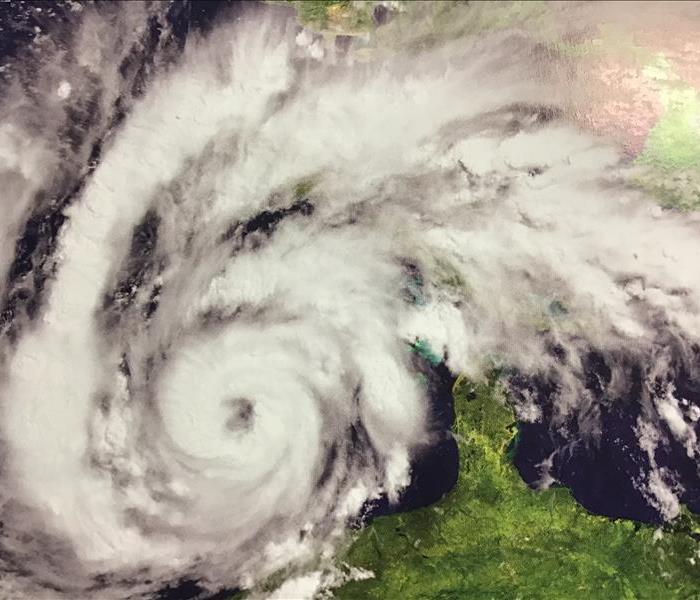 If your home or business is affected by severe weather call us at (800) 352-7251. We are available 24/7 to assist with emergency restoration.
If your home or business is affected by severe weather call us at (800) 352-7251. We are available 24/7 to assist with emergency restoration.
Did you know that, according to noaa.gov, approximately 98% of all presidentially declared disasters are weather related and that these disasters cost nearly $15 billion in damage? It is important to know the potential risks of severe weather as well as how to take the appropriate action. Below are a few key guidelines to keep in mind for severe weather:
Understand your risk. Knowing what is going on with the weather in your hometown is the first step in protecting yourself, your family, your home and your business in the event of severe weather. Check the forecast regularly, know basic weather terminology and understand what types of weather can impact your area (i.e. if you live in a flood zone). Having a NOAA Weather Radio or signing up for Wireless Emergency Alerts for your area are another way to stay aware of local weather.
Take action. Create a communications plan for your home and/or business and have an emergency kit prepared just in case. Store important papers/valuables in a safe place.
Be an example. Once you are prepared for severe weather, share your story with others. Your preparedness efforts may inspire others to do so as well.
3 Ways Winter Storms Can Damage Your Home
12/9/2019 (Permalink)
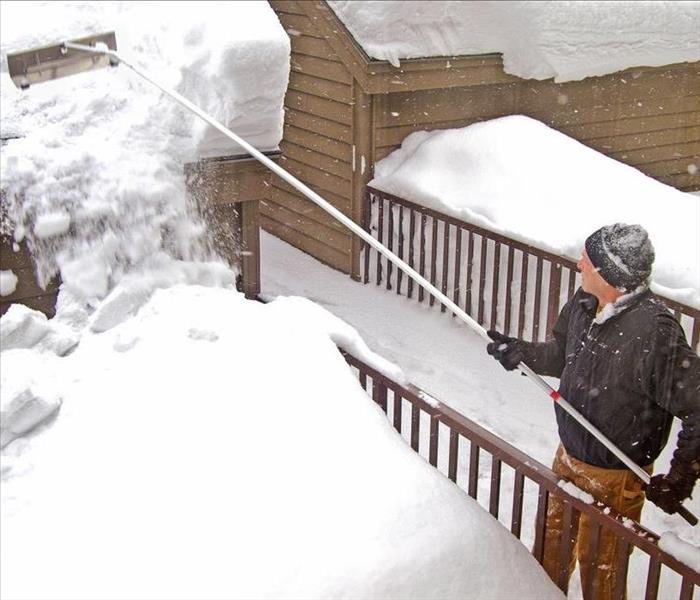 If a storm hits your home or business, call the experts at SERVPRO of Cheshire County
If a storm hits your home or business, call the experts at SERVPRO of Cheshire County
Winter storms can be surprisingly destructive, even without record-breaking snowfall. Ice is dangerous long after the storm passes, not only when it falls, but also as a potential flooding hazard. To avoid an emergency, keep an eye out for the following conditions — or you may need water cleanup and restoration services this winter.
3 Wintertime Flood Hazards
Ice Dams
If a house isn’t correctly ventilated in the attic, heat will rise through the roof peak, causing the center of the roof to be warmer than the edges. After a snowstorm, this uneven temperature distribution causes the snow to melt at different rates. Ice then accumulates near the perimeter and keeps snow-melt from draining through the gutter system. This process is called ice damming. As the snow melts, water can dislodge the shingles and roof flashing and even pry apart gutter seams. Because water expands when it freezes, the cycle of freezing and thawing can magnify this damage.
If ice dams form on your gutters, water can eventually permeate the roof and cause wood-rot, mold, and drywall damage in your attic.
To combat ice dams:
- Use insulation and caulk to keep the attic and roof cold.
- Add roof and soffit vents to improve the ventilation outside your home.
- Install a waterproof under-layer beneath the roofing shingles.
Snow Accumulation on the Roof
Another potential risk during the winter is snow accumulation. If heavy snowdrifts form on your roof, the weight can cause the structure to collapse. Various factors, such as the pitch and condition of your roof, affect the likelihood of this scenario. In general, if your house is up to code, it should be able to withstand average snowfall. For more information about snow accumulation on the roof, check the Federal Emergency Management Agency website.
Frozen Pipes
Frozen pipes are typical during the winter, especially in unheated rooms with water pipes, like the basement. Water sprinkler lines and hose bibs are also more susceptible to freezing, as the pipes are along exterior walls.
When a water pipe freezes, pressure builds until the pipe bursts. This usually causes flooding until the supply line is turned off. A frozen pipe typically requires water cleanup services.
To keep pipes from freezing:
- Insulate pipes with specially designed foam sleeves.
- Heat areas of your home that have water pipes.
- Winterize outdoor plumbing fixtures, including sprinkler systems, pools, and garden hoses.
If a storm hits your home or business in the Westmoreland, NH area, call the experts at SERVPRO of Cheshire County at (800) 352-7251 for immediate water cleanup and restoration services. Our company is locally owned and operated yet comes with the support and resources of a nationally recognized franchise.
Things You Can Do to Stay Safe at Home Through a Winter Storm
11/26/2019 (Permalink)
 If Your Home is Damaged in the Event of a Storm, You Can Call Us Anytime at (800) 352-7251.
If Your Home is Damaged in the Event of a Storm, You Can Call Us Anytime at (800) 352-7251.
Before the Storm
Knowing the difference between a winter storm watch and a warning is important. The National Weather Service (NOAA) will issue a winter storm watch when there is a potential for heavy snow or significant ice accumulations, usually at least 24 to 36 hours in advance. The criteria for this watch can vary from place to place. NOAA will issue a Winter Storm Warning when a winter storm is producing or is forecast to produce heavy snow or significant ice accumulations. The criteria for this warning can vary from place to place. Keeping an eye on the weather in your area is one thing that can help you stay safe during a winter storm, especially if you need to travel. For more alert terms visit noaa.gov.
Have These Items Ready at Home During a Winter Storm. These Will Especially Come in Handy if You Lose Power and It’s Unsafe/Impossible to Travel:
- Flashlight
- NOAA Weather Radio
- Extra Batteries
- First aid kit and any necessary medications
- At least a 3-day supply of water (1 gallon per person daily)
- Non-perishable food
- Matches
- Candles
- Shovel/Roof Rake
- Cell Phone with Charger
During the Storm
- Only travel if necessary, fill your gas tank before the storm rolls in and keep a supply of emergency items in the vehicle:
- Blanket
- Jumper Cables
- Hand/Toe Warmers
- Warm clothes (hat, gloves, scarf, etc….)
- Non-perishable snack food
- Water
- Flashlight
- Tow Rope
- Spare Tire
- Sand or Kitty Litter
- Snow Shovel and Brush
- Cell Phone Charger
- First Aid Kit
- Listen for any critical information from NOAA.
- Dress in layers to stay warm.
Protecting Your Home From Winter
10/17/2019 (Permalink)
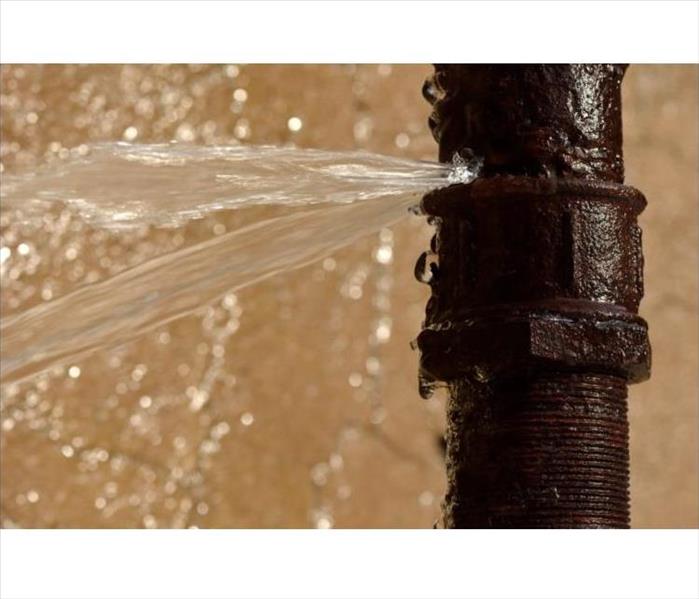 Protecting your home during the cold months is critical in avoiding costly damage from frozen pipes, ice dams and other winter related hazards.
Protecting your home during the cold months is critical in avoiding costly damage from frozen pipes, ice dams and other winter related hazards.
It feels like fall just arrived but winter will be here before we know it. Folks often wait until the last minute to stack firewood, find the time to take down the gutters and prepare their homes for the cold months. Taking the time to prepare for winter is critical to have a comfortable and safe winter and can save your home from potential damages. Taking the time to strengthen your home’s defense against winter will save you a headache down the road. Here are a few tips to protect your home in preparation for the cold months:
- Ensure you have plenty of fuel for heating your home. No matter how you heat your home, budget during the warmer months to set aside money for oil, wood, etc…
- Is your home drafty? Consider wrapping the inside of your windows to cut down on the drafts and save some on fuel costs. Window wrapping kits can be found at most hardware/home improvement stores.
- With every storm, be on the lookout for ice dams and heavy snow accumulation on your roof. These can cause significant damage if not removed properly.
- On the coldest nights opening your cabinets and vanities so that warmer air in your home can circulate around the plumbing will help keep your pipes from freezing.
- Having more than one heat source, if possible, is a great way to ensure your house stays warm enough. For example, supplementing some of the heat you would get from your baseboards by utilizing a wood stove can help not only cut down on the oil you use but also save your home in the event of a long power outage.
- If you know you are going to be away from home during a storm, ask a trusted friend, neighbor or relative to check on your home. This simple favor could be what saves your home from burst pipes during freezing temperatures.
Protecting your home during the cold months is critical in avoiding costly damage from frozen pipes, ice dams and other winter related hazards. If you do experience a loss due to winter weather call us. We are available 24/7.
(800) 352-7251
Is Your Home Hurricane Ready?
8/15/2019 (Permalink)
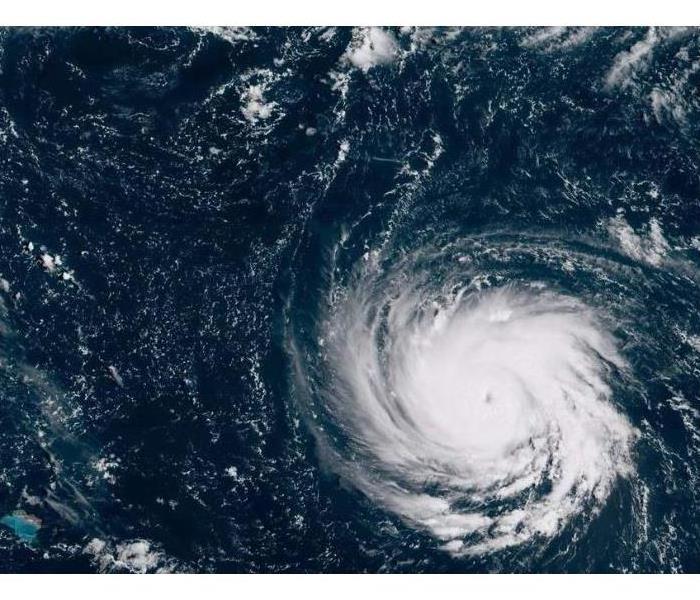 When wind conditions are right, hurricanes can form over warm ocean waters.
When wind conditions are right, hurricanes can form over warm ocean waters.
Spring and Summer are beautiful seasons and are certainly welcomed with open arms in New England. The warm months offer time to explore new hiking trails, do a cannon ball off the dock at your local lake and look for seashells along rolling tides and golden sands. With spring and summer also come the threat of hurricanes. A massive storm system that begins over warm ocean waters and moves inland is known as a hurricane. Hurricanes are known to produce hazards such as heavy rain, floods, rip tides, landslides, strong winds, storm surges and even tornadoes. These massive storms are capable of causing large amounts of destruction to properties and even fatalities to those in affected areas. Below are a few suggestions to help you be hurricane ready:
- Have an emergency plan in place and learn your area’s evacuation routes and local emergency shelters
- Do your homework: A little research about the area you live in will help you understand the likelihood of a hurricane and how severe the storm could potentially be.
- Store emergency supplies in a place that’s safe and easy to reach. This should include basic survival items such as potable water and food (3 days supply or more), first aid items, a flashlight and batteries, a weather radio so you can listen to storm updates and any vital
- If you live in a flood zone, always be on the lookout for warning signs during a storm (such as heavy rain)
- medications
- Sign up for NOAA (National Oceanic and Atmospheric Administration) and EAS (Emergency Alert System) to stay informed on current local weather
If your home does experience storm damage, please feel free to call us. We are available 24/7.
(800) 352-7251
Staying Safe During A Thunderstorm- Emergency Outdoor Safety Tips
5/10/2019 (Permalink)
 "If you can hear thunder, lightning is close enough to strike you." - National Weather Service
"If you can hear thunder, lightning is close enough to strike you." - National Weather Service
When a thunderstorm rolls in, it’s best to find shelter fast. But if you’re caught outside during a thunderstorm, it’s important to know the do’s and don’ts of how to protect yourself. If your car is nearby, you can take shelter inside your vehicle until the storm passes. Put the windows up and then stay put until the storm passes. If you are far from any shelter, here are some last resort tips from the National Weather Service to reduce the risk of getting struck by lightning:
- Never lie flat on the ground.
- Never shelter in or under an isolated tree.
- Immediately get off elevated areas like mountain ridges or peaks and hills.
- Never use a cliff or rocky overhang for shelter.
- Keep away from objects that are conductive, i.e. power lines/transformers, windmills, metal fencing.
- Stay clear of bodies of water.
For weather forecast and safety information visit the National Weather Service website: www.weather.gov
Staying Safe During A Thunderstorm- Indoor Safety Tips
5/7/2019 (Permalink)
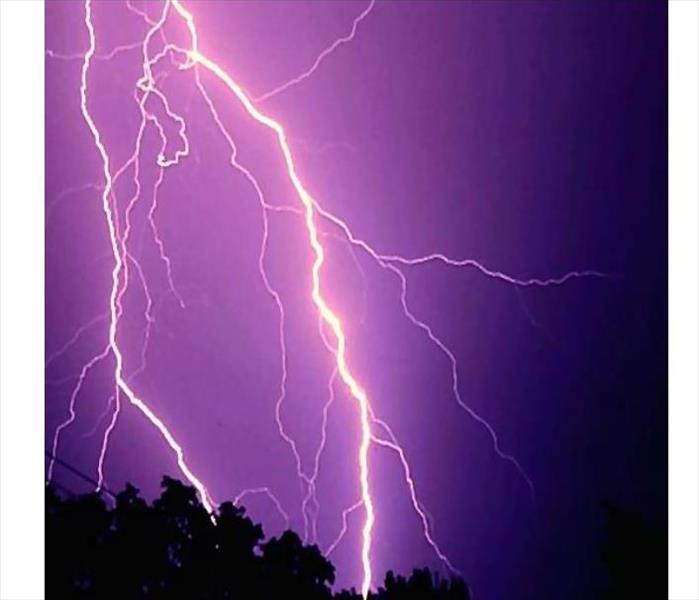 Lightning Near Power Lines
Lightning Near Power Lines
Thunderstorms can be exciting to watch but it is important to also be aware of and protect yourself and your family from the potential hazards associated with thunderstorms.
Thunderstorms can produce hail anytime during the storm. Hail can vary in size from smaller than the size of a pea to the size of a grapefruit! These chunks of ice can plunge to earth at speeds up to 120 mph.
Thunderstorms also produce lightning which can kill or seriously injure one caught in its path. Here are some safety tips to follow once you get indoors:
- Don’t use corded phones and electronics like power tools or computers. The electrical wires can conduct lightning.
- Don’t use the shower/bathtub, wash dishes, do laundry or wash your hands as the metal plumbing is also conductive.
- Stay away from windows, skylights and doors as high winds and hail can break the glass.
- Keep candles, matches/lighters, flashlights and batteries in a secure and easy to reach location in case they are needed during a power outage.
- Always have emergency non-perishable food and potable water in your pantry just in case.
- Keep a first aid kit fully stocked and in an accessible location in your home.
- Stay inside until the storm is over.
How Roof Inspections Prevent Storm Damage to Your Dublin Home
12/12/2018 (Permalink)
 Routine roof inspections can protect your property. We recommend inspecting your roof 1-2 times per year.
Routine roof inspections can protect your property. We recommend inspecting your roof 1-2 times per year.
Roof Damages Can Cause Flooding in Your Dublin Home
The roof of your Dublin home gets asked to endure many types of severe weather and damaging forces throughout its lifetime. While every situation might not cause catastrophic failure to this external defense for your property, even a small puncture from a tree limb or flying debris can be enough to allow substantial runoff and torrential rainfall to pour into your home’s attic space.
While many do not often correlate storm damages to floods in their Dublin residence, the better prepared you are for the possibility, the sooner that our professionals can arrive on the scene and get to work on mitigating your loss. The initial advice in this situation is to keep close tabs on the structural integrity of your roof as best as you can. Have this part of your home inspected once or twice a year to determine areas that could become vulnerable and require repairs to avoid flooding or structural failure.
Since this advice often gets regarded in hindsight, you might benefit from understanding how our SERVPRO professionals can make a difference quickly when your home experiences flood damages. Our rapid response team arrives with the full measure of our extraction and drying equipment designed to slow the spread of flood damages throughout the property and remove the excess water in our initial visit to your home.
These same SERVPRO technicians can help to protect your property by providing roof tarping or emergency board-up services to stop the flow of water into your house. Once the source has stopped supplying water to the affected areas, our professionals can get to work quickly on assessing structural concerns and removing at-risk contents of the house to prevent irreparable damages.
When you contend with flooding in your home from a damaged roof, you need assurances that a team of qualified professionals can arrive quickly to keep the problem from worsening and beginning the necessary steps to restore what has happened. Our SERVPRO of Cheshire County rapid response team has the experience and the equipment to restore your home quickly after a flood. Give us a call today at (603) 352-7251
Click here to read more about Dublin.
What Goes Into Our Restoration Process For Your Flood Damaged Dublin Home
11/27/2018 (Permalink)
 In case your property floods, calling SERVPRO of Cheshire County helps ensure proper restoration.
In case your property floods, calling SERVPRO of Cheshire County helps ensure proper restoration.
What You Need To Fix After Flood Damage In Dublin
Flooding damages Dublin properties in many unique ways depending on how the incidents unfold. Restoration can, therefore, mean different things. If winds push debris and puncture a hole on the roof or another part of the structure allowing rainwater to flood the property, the restoration processes would differ slightly from a case of flooding from rising water. Because of our IICRC certification and experience restoring properties, we understand the main problem areas, and how best to deal with them.
Identifying the level of moisture migration is crucial when restoring flood damage in Dublin because excess moisture affects everything from the structure to the contents in the property negatively. Whatever material is in the loss area whether it is concrete, wood, upholstery or metal among others deteriorates when a property floods. Luckily, it is easy to forestall most of the effects by limiting exposure time. Our SERVPRO team identifies the level of moisture migration using advanced tools like FLIR thermal cameras, moisture sensors, and meters, which help determine the extraction and drying equipment to use for fast results.
Removing debris, soiling, and contamination is also essential. The level of cleaning depends on the source of water. Flooding involving rising water dumps the most soils and contaminants including raw sewage into the property. Proper cleanup includes removal of porous materials affected by the floodwaters. Our SERVPRO crew is fully equipped to remove carpets, particleboards, insulation and any other porous materials affected by the water. We also have pressure washers to clean non-porous materials effectively. We spray EPA-registered disinfectants in the affected areas neutralizing contaminants.
Restoring flood damage involves teardown, whether it is to ease cleanup, or to help with moisture control. Doing such teardown requires skills to avoid causing unnecessary damages that exaggerate cost. Our SERVPRO crew performs a flood cut two feet above the water line. We also have the necessary tools to remove baseboards, door frames and other parts of the structure without ruining them. When the property is clean and dry, we can put everything back together nicely “Like it never even happened.”
In case your property floods, calling SERVPRO of Cheshire County helps ensure proper restoration. You can reach us at (603) 352-7251 any time.
Click here for more about Dublin.
Our Highly Trained Professionals Can Save Your Home And Belongings After A Flood In Walpole
10/17/2018 (Permalink)
 Flood damage in the Walpole area can destroy your mattress and other items in your home.
Flood damage in the Walpole area can destroy your mattress and other items in your home.
Should You Save Your Mattress After A Flood Damage In The Walpole Area?
Rainstorm or any bad weather can ruin your plans. The worst part is that mother nature can get out of control, and bring a tremendous amount of water leading to a flood that can ruin your property and belongings. One of your most valuable items is your mattress.
Flood damage in the Walpole area can destroy your mattress and other items in your home. You might be wondering if it's worth restoring it or if you should discard it. Before you spend hours fixing a water damaged mattress or even hiring a company to dry it, here are some things to consider. If this is a cheaper or older mattress, then you are better off getting a new one. If the mattress contains material like foam, rubber, or cotton, then you should get rid of it because mold and mildew can grow inside of the mattress where it can be difficult to clean. If the mattress contains springs, then there is a big chance that it might survive the aftermath of the flood. After all, the spring material allows for adequate airflow. Unfortunately, in the aftermath of a flood, it is best to discard the mattress because flood water contains a lot of contaminants from the sewage system and other components.
Luckily, the SERVPRO technicians are experts when it comes to flood damage. They can inspect your belongings to see if anything is salvageable. The SERVPRO tech can utilize advanced technology and process such as the mitigation procedures and high tech vacuum system to get rid of excess water from your establishment. They can inspect your place to search for hidden water as well as getting rid of unsalvageable items and mattresses. It is essential to let these experts check your belongings before determining if you can keep it or not.
If you are interested in getting a reliable technician to inspect your home and belongings after a flood, then you can give SERVPRO of Cheshire County a call at (603) 352-7251 for a consultation with our skilled technicians.
Click here for more about Walpole.
Cleaning Up After Flood Damage Visits Your Keene Neighborhood
8/16/2018 (Permalink)
 SERVPRO is always ready to help residents in Keene cleanup after a disaster involving flood damage happens.
SERVPRO is always ready to help residents in Keene cleanup after a disaster involving flood damage happens.
Cleaning Up After A Flood
While no one likes the idea of living through a flood, knowing how to react to one can help save you unnecessary expense and hardship, should one ever come to your part of Keene. Flooding can happen for several reasons and cover large areas of the city or just a low-lying neighborhood.
SERVPRO is always ready to help residents in Keene cleanup after a disaster involving flood damage happens. The restoration of your home is crucial to its safe and healthy condition. Merely letting a home air dry after a flood leaves behind illness-causing pathogens, increases the chances of microbial infestation, and allows water damage to develop unchecked. We can help you get everything back under control and healthy again, “Like it never even happened.”
Because evaporation of flood waters lifts water vapor into the air, we need to work quickly to protect areas in your home that are currently undamaged. High levels of moisture in the air can damage other materials, including structural components, throughout your home. We arrive with the proper equipment to both dry and clean your home back to sanitary conditions, so you don't need to worry about your children becoming exposed to harmful elements of contamination within your home.
We use cleaning tools that remove silt and other debris from all surfaces in your home, and HEPA-filters on all of our vacuum cleaners. We also use chemical agents to clean both non-porous and porous items, so we eliminate any remaining pathogens.
While many of our cleaners leave a fresh and pleasant scent, hidden microbes can produce more unpleasant scents. We can eliminate these odors quickly if needed, so your home becomes more and more like it was before the disaster.
Removing damaged materials also helps eliminate odors as well as hazards in your home. Wherever we see damaged materials, we remove these so we can replace them with similar items. However, when we find we can clean the item instead effectively and thoroughly, we choose to do this, instead. This keeps your restoration costs more manageable, and can also help make the entire process faster.
SERVPRO of Cheshire County is always ready to help those in Troy, Dublin, and Fitzwilliam through disasters like flood damage. Disasters happen without warning, and that is why we are always on your side, available merely by calling our 24-hour emergency line, (603) 352-7251, 365 days a year. Call us, and we can send out an IICRC-certified team to your home to make things safe again.
Click here for more about Keene.
Severe Weather Can Mean Flood Damage in Dublin
7/20/2018 (Permalink)
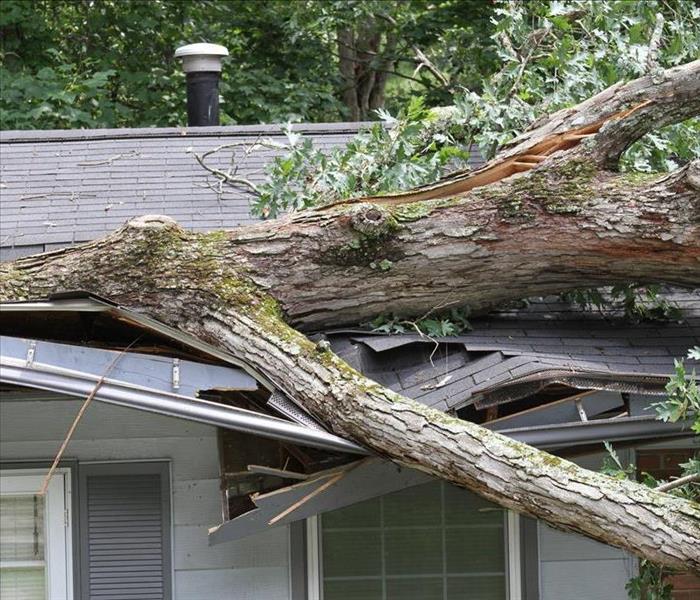 Storms, Winds, Trees, Water Damage in Dublin--What To Do? Call SERVPRO
Storms, Winds, Trees, Water Damage in Dublin--What To Do? Call SERVPRO
Dublin Storm Damaged Properties--The Solution is SERVPRO
Already this summer significant rains and wind storms resulted in toppled trees and utility lines near Dublin. The damage from a severe storm can expose many areas of your house to swiftly moving water, as well as threatening to submerge the lower levels of your dwelling under several inches of water. You need professional assistance from a reliable restoration company.
When your Dublin residence experiences the destruction heavy tree branches bring, the flood damage can be shocking. The amount of water flooding into your home from many different access points is far more than a shop vac can manage. Waiting for the waters to recede risks secondary damage. Our storm and flood damage crews are on call 24/7 when our community needs an emergency response.
To limit additional damage to your home, SERVPRO first secures and stabilizes the damaged exterior with boards and tarps. Then we inspect the damage done as the water rushed from the roof and upper levels into your basement. Chances are good your power may be temporarily disconnected, but this does not delay our efforts to remove the water collected in your lowest level. Our vehicles feature gas-powered submersible pumps and truck mounted water extractors that operate to capacity from our onboard generators.
SERVPRO crew members trace the path of the water, taking moisture readings or infrared scans of the walls, steps, ceilings, and floors affected. We can mark these wet areas with Blue Painters' Tape. The moisture levels inform our drying goals and also help us pinpoint any hidden caches of water. Release and extraction of hidden water are crucial to avoid microbial growth and structural component deterioration. We might drill holes or remove sections of drywall to access the water.
Although the source of the rainwater is relatively clean, SERVPRO crew leads evaluate the quality of the water in the lowest level. The failure of the municipal system to manage the storm sewer overflow during heavy rains can cause a backup of human waste into your home that requires special handling. If chemicals or paints stored in the basement tip into the flood waters, contamination is proven as well. Under these circumstances, we need to contain the extracted liquid and check with local rules on how to appropriately dispose of it.
Once the majority of the flood water exits via pumps and extractors, SERVPRO employees position air movers, heaters, and dehumidifiers to remove water from porous structures. The mantra every technician memorizes is wet to dry, and we ensure water moves into the drier, warmer air to then be condensed or absorbed by refrigerant or desiccant dehumidifiers.
Do not delay your call to (603) 352-7251 for help with storm-related home flooding. SERVPRO of Cheshire County is ready and able to respond fast with the highest degree of professionalism.
Click for your local city hall
Professional Mitigation Helps Protect Families after Disastrous Flood Damage in Dublin
5/22/2018 (Permalink)
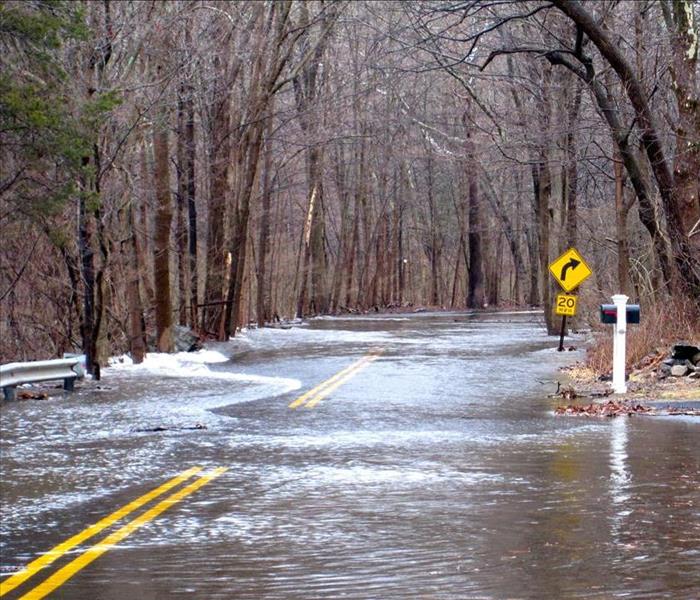 SERVPRO Says Keep Your Family Safe from Flooding in Your Dublin Home
SERVPRO Says Keep Your Family Safe from Flooding in Your Dublin Home
SERVPRO Can Offer Excellent Flood Water Removal and Cleanup and Restoration Services
Living in Dublin provides everyone with loads of lovely scenery and fantastic changes between seasons. Sometimes these changes bring undesired events to our front door, and then over the threshold.
If your Dublin residence happens to face flood damage, you know your home needs immediate professional mitigation that can stop the progression of a flood's destruction. Flooding is only the beginning of such a catastrophe. How you respond to this terrible event can determine the outcome that your home experiences. When you call us, We're Faster To Any Sized Disaster, meaning we also finish the work more rapidly. Quicker response from us helps minimize many of the different possible types of damage from ever developing, saving you money, as well.
Extracting the water left behind after flooding can reveal enormous amounts of silt and mud caked onto not only your floors but underneath furniture and inside cabinets. We remove this filth and clean your household furnishings. This may include a pack-out to our dry facility for cleaning and storage. Afterward, we proceed to dry things out and then begin restorative work, including odor control management. The many stages of mitigating after flood damage may seem complicated, but our highly experienced IICRC certified employees deliver results that make your home safe and comfortable once again.
Many items and materials become so damaged that protecting your family requires disposal of them. Typically, the final say on discarding elements rests with you and your insurance adjuster, if one is involved. While we can sanitize your entire kitchen, including cookware and serving sets, all food items that came into contact with the floodwaters can make your family seriously ill if they consume this potentially contaminated food. This disposal includes all canned goods, even though they may seem impenetrable. Groundwater from floods is always considered Black Water, full of bacterial, fecal, and chemical components.
SERVPRO of Cheshire County's professionals are ready to serve the area from Walpole through Keene to Rindge and all the way 'round our beautiful county whenever flood damage affects a home. Call us at (603) 352-7251 so our friendly mitigation specialists can assist your family in returning to a beautiful home once again.
Visit the highest village in New England right here
Water Removal from Basement After Heavy Rains in Dublin
2/25/2018 (Permalink)
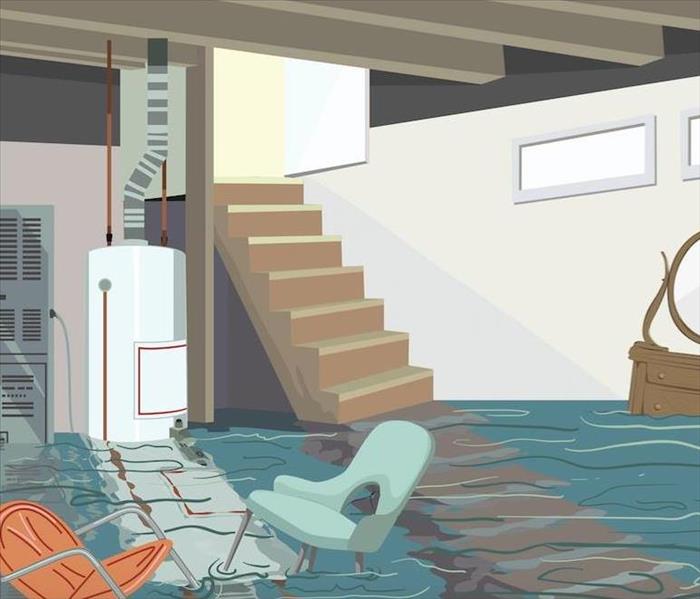 Basement flooding can damage many things that you have stored as well as any exercise equipment. Contact SERVPRO for quick action.
Basement flooding can damage many things that you have stored as well as any exercise equipment. Contact SERVPRO for quick action.
SERVPRO Technicians Methodically Dry Out Your Flooded Basement and Lower Overall Humidity to Prevent Secondary Damages
Your basement in Dublin can flood at any time, even if it has never happened before. Most flooding occurs during heavy rainstorms. The flooding can occur from flow or seepage through your foundation floor or walls. Basements are inherently prone to flooding, as they are the lowest level of your home and usually partly or entirely below ground level. Rain can seep into your home through poor lot grading or an unmaintained foundation with cracks in it.
When rainstorms have caused flooding in your Dublin home basement, you need to act fast to get the water removal done. Water is quick to damage any belongings you may have stored in this area of your home, and additional damage, such as mold growth, can begin shortly after an area is saturated. SERVPRO is always standing by with the training and tools to help get your home dry again fast.
Getting your home dry fast is essential, and four factors affect how much time is needed for drying which includes how much water needs to be evaporated, the temperature of the area, humidity, and air movement.
When temperatures are between 70 and 90 degrees, drying occurs faster since hot air can hold more moisture. If heat is not available, SERVPRO staff may use portable heaters. The temperature in affected areas should ideally be between 70 and 80 degrees.
The more water we pump or extract from your structure, the less we have to remove with dehumidifiers. Liquids are faster and easier to remove than gases, and physical extraction is 1200 more times efficient than dehumidification. We use a submersible pump if there are two or more inches of standing water in your basement. We spend the extra time extracting to reduce drying time later. If there is carpeting in your basement, removing the pad first helps to speed things up.
Relative humidity is how much moisture is present in the air at a given temperature. Dehumidifiers are the most efficient way for us to lower the relative humidity. They remove the evaporated moisture from the air and return the affected area to its normal humidity levels.
The last thing important to drying is air movement. Air in your water damaged basement usually is humid and damp, slowing evaporation. When we blow the damp air out and bring in warm, dry air, it speeds up the drying process. We position the air movers correctly to help us and change the location of them as drying progresses to promote thorough, even drying of all surfaces.
SERVPRO of Cheshire County has the proper tools and experience to dry your basement in Swanzey, Walpole, or Fitzwilliam back out again after rainwaters have seeped in. As soon as you realize a problem, give us a call at (603) 352-7251 so we can get there fast and avoid further damage.
For more information regarding Dublin, click here.
Drying Behind Cabinets After Flood Damage in Your Walpole Home
1/28/2018 (Permalink)
 Cabinets can harbor mold if not dried out correctly. Make sure that the kick board is removed and checked for moisture after an event in your home.
Cabinets can harbor mold if not dried out correctly. Make sure that the kick board is removed and checked for moisture after an event in your home.
SERVPRO Technicians Use Different Techniques to Dry Out Your Property Based on Where the Floodwaters Pooled
The weather in Walpole, just like anyplace else, can be unpredictable. You never know when severe rain or thunderstorms can blow through town. Besides wind and lightning strikes, torrential rains can also be a problem, causing flooding as the rain comes down faster than it can properly drain. When something like this occurs in your neighborhood, you do not have to face it alone.
Flood damage to your Walpole home from storms can be overwhelming to deal with. After your home floods, there is much work to be done in getting it back in order. That is why SERVPRO is always available to help you when you need. We can get to your home quickly, and we have the training and equipment needed to take care of the water and damages in your home.
Drying walls and floors behind or under cabinetry can be tricky. Walls behind cabinets take more time to dry since there are multiple layers of the cabinet back and drywall. The cabinets’ construction affects drying. If there is no back, we may be able to drill holes in the wall so air can circulate into the wall cavity. Once the wall is dry, we cover or patch the holes.
If the walls were exposed to moisture for an extended period, and the sheetrock could loosen, SERVPRO techs think about drilling holes in the top of the wall, which lets greater airflow into the wall cavity. If the wall is an exterior wall, the fiberglass insulation might also be saved using this technique.
The space below the cabinet is known as the toe-kick. It is usually made of a material which is less expensive than the cabinet boxes. Base molding could be mounted on the front of the toe kick. We remove the base molding and drill holes in the toe-kick to provide airflow under the cabinet. The area is treated with the right biocide, and then we use a vent system to force dry air back into the cavity of the toe-kick. Once the drying process is complete, the shoe molding or base are replaced.
SERVPRO of Cheshire County takes time to dry and clean all areas of your home thoroughly so that your home in Jaffrey, Chesterfield, or Troy is safe again after flood damage. Just get in touch with us at (603) 352-7251 any time you need us.
Click here for more about the city of Walpole.
How Can Professionals Help Deodorize Your Walpole Home After a Flood?
12/22/2017 (Permalink)
 Walpole Flooding Can Destroy Carpets, Call SERVPRO for Fast Water Removal
Walpole Flooding Can Destroy Carpets, Call SERVPRO for Fast Water Removal
Foul Smells Often Accompany Flooding Incidents, Get Water Removal Fast
Water damage after a natural disaster such as a storm, hurricane or floods can have a long-lasting impact on your Walpole home. Even after the standing water is removed, the residual moisture can cause many problems if not properly eliminated. One such problem is odors.
Here at SERVPRO, our IICRC certified technicians work round the clock to eliminate residual moisture and odor from your Walpole home after flooding. We use multiple strategies to eliminate even the strongest odors lingering after water removal. Here are some of the methods that our technicians use to help your home smell like home again.
Deodorizing carpets
Carpets are notorious for developing a dank, foul smell after a flooding incidence. If the water is severely contaminated, the flooring material must be discarded. The odor can linger on long after the water is removed from your property if proper measures are not taken during the process.
SERVPRO technicians use EPA-registered disinfectants to sanitize both carpet and the underlying floor and eliminate the odor at its source. We also use Ultra Low Volume (ULV) Foggers and Thermal Foggers to combat tough-to-eliminate odors.
Upholstery
Odor problem can be quite a huge problem if your upholstery is damaged during the flooding. SERVPRO technicians use some of the strongest deodorizers to combat upholstery odors. We understand that upholstery fabric can be delicate and use caution while cleaning and deodorizing such materials. Soft brushes and foams are often employed for cleaning.
Hard surfaces and floors
Even hard surfaces such as hardwood flooring and floorboards can develop a smell after flooding. We use EPA-registered disinfectant and foggers to eliminate odors from such surfaces.
Walls, ceilings and other areas
Although walls and ceilings do not pose a significant odor problem, we make sure that they are treated with disinfectants and deodorizers to prevent any future issues. Our technicians also use deodorizing pellets to eliminate any sharp scents resulting from accumulated water.
The best way to eliminate odor problem is prompt water removal. Most issues arise due to inefficient water removal and drying.
Call SERVPRO of Cheshire County at (603)352-7251 today to schedule an appointment with our experienced and trained experts and get rid of that odor once and for all.
More information regarding this town by clicking here.
Restoring Dublin Flood Damage
10/20/2017 (Permalink)
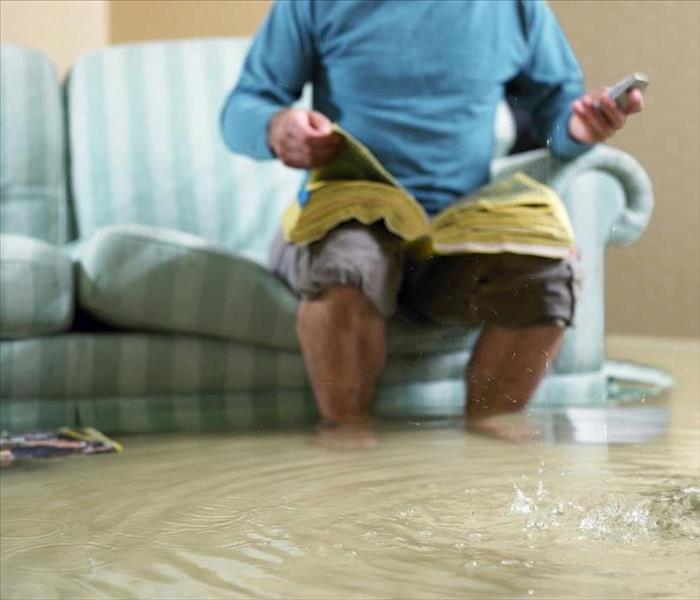 Let SERVPRO help you make the decision about what furniture to save or let go and restore your home after flood damage.
Let SERVPRO help you make the decision about what furniture to save or let go and restore your home after flood damage.
SERVPRO Helps Make the Decision to Restore or Replace Your Furniture After a Flood to Keep Your Home Safe and Clean
After a significant storm, Dublin residents have to make tough decisions. The resulting floods turn what were once family heirlooms into a pile of scrap. Bedroom sets and other furniture older than some cities in our country are now worth little more than firewood.
Dublin flood damage decisions can be even more difficult, but getting assistance from a professional remediation company helps. SERVPRO has helped many of our neighbors determine what is salvageable and what has to be thrown out. For items salvaged, we can also work with the major insurance companies to make sure you get what your policy owes you.
We make our recommendations based on guidelines issued by the Institute of Inspection Cleaning and Restoration Certification (IICRC). As an example, a sofa that was in the water just up to its legs causes some minor damage and perhaps ruins the finish on the legs. It is relatively minor in cost, and an insurance company signs off on the repair work.
If the sofa was in deeper water and the upholstered material has begun to shrink, or the color has begun bleeding into the water, it is not replaceable without significant expense. In most cases like this, insurance companies determine it is cheaper to replace the item rather than attempting to restore it.
If the owner still decides to restore it, SERVPRO can do that. We make sure the customer understands that there are no guarantees because of the damage, but if they agree, we do our best to return the item as close to its pre-flood condition as possible.
We use air movers to dry the legs and the upholstery. The machines can be adjusted to gently blow warm air over the wood and fabric to prevent warping and shrinkage. There is little to do for lost color pigments, but if the location is near the bottom of the sofa, it may not be too noticeable and is acceptable to the customer. Technicians can also refinish the legs to match the original color.
Our goal is to help you put your home back together. It sometimes means making hard decisions and letting go of a few items to make a safe, clean home for your family once again. If you are in this situation now, call SERVPRO of Cheshire County at (603) 352-7521 today. We are here for you.
Visit http://townofdublin.org/ for more information about Dublin, New Hampshire.
Dealing With Flood Damage in Keene After A Storm
9/8/2017 (Permalink)
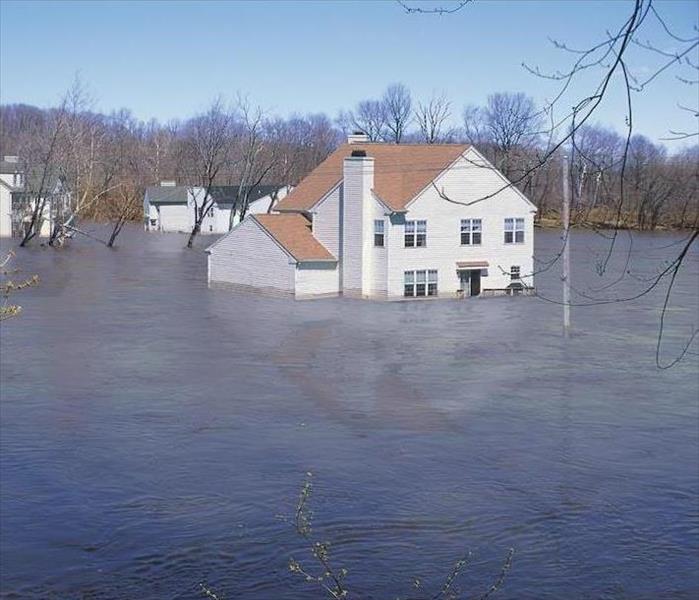 When floodwaters affect your entire region, it's time to call the trained technicians at SERVPRO to remediate the damage in your home.
When floodwaters affect your entire region, it's time to call the trained technicians at SERVPRO to remediate the damage in your home.
Removing Water Correctly After Flooding is Key in the Remediation Process
Although the attention is directed South right now, flooding can happen along our Eastern coast just as easily. Successful restoration of homes and property after a hurricane or any other storm depends in part on how quickly a response team arrives and when they start working.
Cleaning up flood damage in Keene after a storm can take a significant amount of time. It is important that a homeowner can contact a service and receive an immediate response to their request. It is why SERVPRO maintains a Response Team on a 24-Hour recall.
We know from years of experience that arriving at a home within an hour after the request for help is worth days of work and potentially thousands of dollars. The faster we can pump out any standing water means that walls, floors, and carpets start to dry out that much quicker. Depending on the size of the structure, our technicians can finish the job in less than a day. Even in larger homes (i.e., a mini-mansion), we take no more than two.
With the water gone, we start work on two keys tasks; drawing out water trapped in carpets and wooden floors as well as drying out walls with excessive moisture. For carpets and floors, we deploy several types of water extraction wands. These vacuum tools are designed to remove water without causing harm to the nape of the carpet or further damage to the surface of wood floors.
Removing moisture from walls and ceilings is a time-consuming task, but doing it right means we do not have to remove and replace ceiling tiles or drywall. Removing moisture is also a cost-saving option in most cases. Technicians set-up dehumidifiers to draw water from the surrounding air. Our larger units can remove over 20 gallons from the air each day.
Other Response Team members establish air movers at key positions in the affected rooms. These devices direct warm, dry air across wet surfaces to force out the moisture where the dehumidifiers trap and remove it. Drywall is fragile when wet, so we carefully control the temperature of the air movers to avoid damaging it.
Using these techniques as part of an overall restoration plan means we can help you return to a dry, safe home as quickly as possible. When you need our services, call us at (603) 353-7251 immediately. The SERVPRO of Cheshire County Response Team is here to help.
For more information regarding Keene, click here
Hurricane Effects In New England Cause Local Flooding in Jaffrey
7/8/2017 (Permalink)
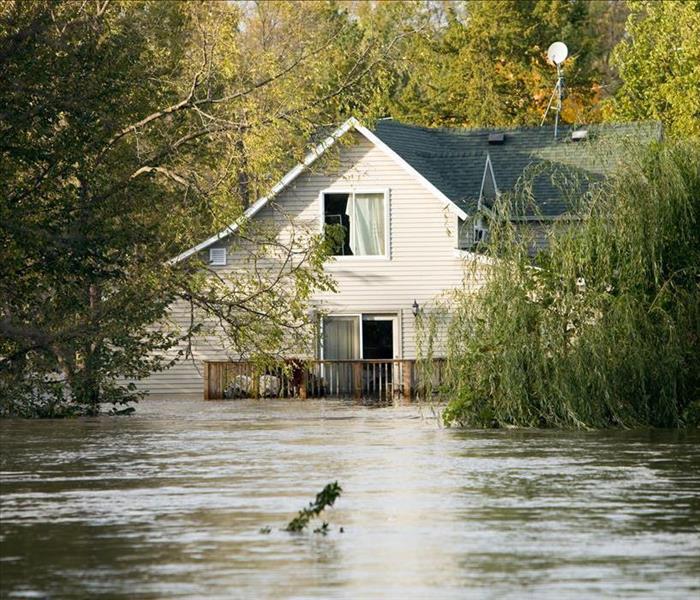 Too Much Water in Your Flooded Jaffrey Home? Contact SERVPRO for Emergency Service
Too Much Water in Your Flooded Jaffrey Home? Contact SERVPRO for Emergency Service
Water Removal is Crucial to Mitigate Damage, Call SERVPRO
The entire East Coast of the United States braces each summer, concerned about the effects of tropical storms and hurricanes. Even in New Hampshire the force of a named hurricane making its way north can be shocking. SERVPRO awaits each hurricane season with confidence in its trained workers and specialized equipment.
Severe storms, moving up from the Caribbean still pack a punch days later, causing flood damage to your Jaffrey home. Persistent and heavy rains saturate the soil, and aging roofs and gutter systems discharge the water through your foundation into your basement. Several inches of water must be removed, a job for our professional restoration company. We can even supply portable and trailered-in generators to power our extraction equipment.
The power water has to damage dwellings is well known. SERVPRO knows how to rid your home of water and stop the damage from progressing. More importantly, we have the training and the experience to transform your living areas back to the condition they were in before the flood. The key to turning back the clock on flood damage is an immediate call to set up an inspection and to develop an individualized plan for your house.
Powerful truck mounted pumps, and water extractors remove standing water and pull lingering moisture out of carpeting or other floor coverings. Speed is essential when dealing with flood waters. If wetness remains even 48 hours, mold growth is possible in your basement. Residual moisture is monitored with precision instruments and reduced using air movers and dehumidifiers.
SERVPRO technicians also seek out hidden pockets of water, common in basements with cinder block construction. The cells in a block fill with water behind the face of the wall and feed mold if not removed. We have imaging technologies to find the hidden water and drain the areas with small holes drilled through mortar joints or at the bottom of individual blocks.
Often mechanical systems including heating and cooling are located in the flooded areas. SERVPRO evaluates if it is safe to operate the systems so recently immersed, and works with other contractors to restore their safe function. Families also store items in basements, and we help homeowners inventory and examine articles submerged. We offer advanced drying methods for non-washable items like electronics, books, and documents. This may range from freeze drying documents in a process called lyophilization to ultrasonic immersion bubble cleansing of soft fabrics.
SERVPRO of Cheshire County is ready to respond if heavy rains cause flooding in your home. Call (603) 352-7251 anytime, day or night, to schedule an inspection and service.
Learn more about Jaffrey here.
Mother Nature: Beautiful Disaster
2/9/2017 (Permalink)
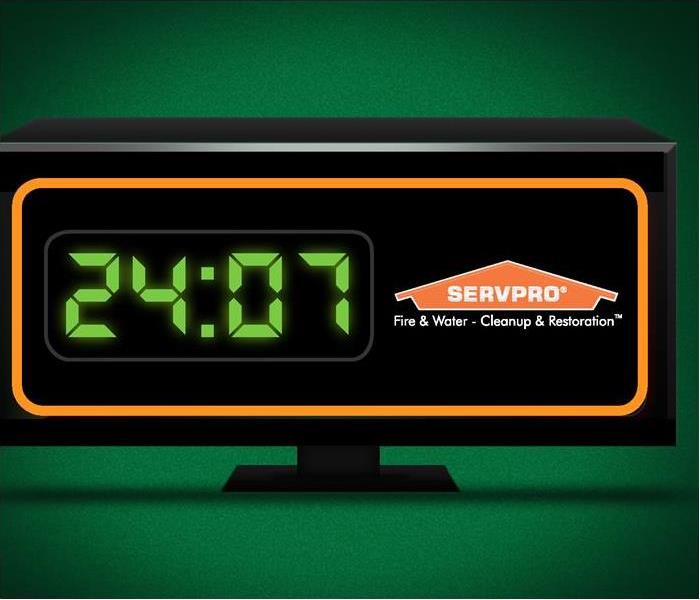 SERVPRO of Cheshire County provides emergency response services 24 hours a day, 7 days a week.
SERVPRO of Cheshire County provides emergency response services 24 hours a day, 7 days a week.
Mother nature in New England, with its vibrant fall colors and vast landscape, is breathtaking. However, despite all its beauty, we are often the subject of particularly harsh natural disasters. Storm and flood damage can be especially devastating and immediate action is needed in order to minimize your damage and make even the worst disaster, "like it never even happened." You'll need a company you can trust to rise to the occasion. SERVPRO of Cheshire County has almost 30 years of experience handling even our most historic storms, which is why you can always rely on us. Additionally, with a network of over 1,700 franchises across the country, we have the resources to handle any size disaster. SERVPRO franchise professionals are dedicated to responding immediately to water and storm related emergencies.
Our technicians are highly trained water damage specialists with expertise including, but not limited to, water damage restoration and applied structural drying. However, we understand that water and storm damage affects much more than just the structure of your home or business but, it also affects your belongings. We know that your family's furniture, clothing, keepsakes, and other belongings help transform a house into a home and that valuable business documents cannot be replaced. This is why our franchise specializes in restoring damaged contents versus replacing them. When your valuable documents including photographs, are damaged by water, extreme caution should be taken to help ensure the water damage does not destroy the document. Although some documents may not be restored to pre-water damage condition, SERVPRO franchise professionals can save a great deal and help minimize additional damage. All of us at SERVPRO of Cheshire County are dedicated to help you make any disaster, "like it never even happened."
September is National Preparedness Month
9/14/2016 (Permalink)
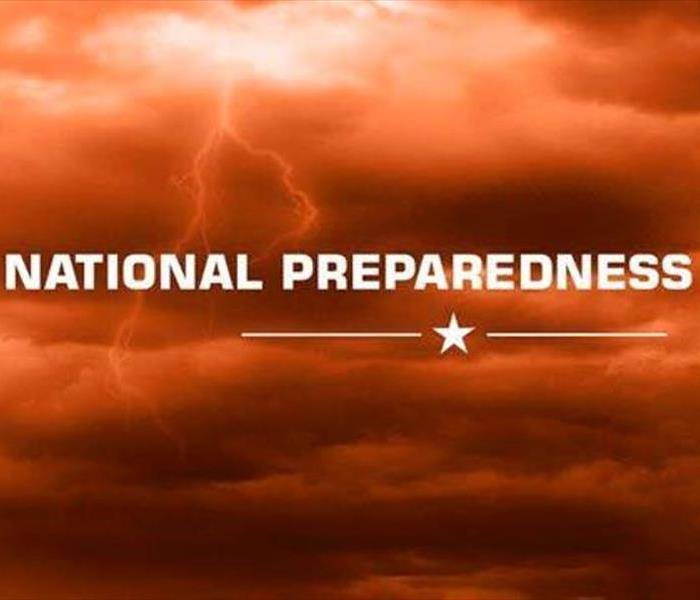 September is National Preparedness Month
September is National Preparedness Month
September is National Preparedness Month. In recent years, many different types of disasters have affected the United States. Flooding, tornados, hurricanes, wildfires and blizzards are natural disasters that can threaten your home, business and community. During National Preparedness Month, SERVPRO of Cheshire Counties professionals want you and your customers to be aware of the steps to take to help prepare for Mother Nature's worst.
How quickly your company can get back to business after a tornado, fire, or flood often depends on the emergency planning done today. The following are basic measures business owners and managers can take to begin preparing.
Develop a Business Continuity Plan
Your organization's risk needs will vary depending on the specific industry, size, scope and location. Carefully assess your internal and external functions to determine which staff, materials, procedures and equipment are absolutely necessary to keep the business operating. Also establish procedures for succession of management.
Review Insurance Coverage
Insurance policies vary: Make sure to check with your agent or provider about things such as physical losses, flood coverage and business interruption. Understand what your policy does and does not cover.
Prepare your Emergency Planed
Your employees and co-workers are your business' most valuable asset. Communication is central before, during and after a disaster. Include emergency information in newsletters, on your company intranet, employee’s emails and other communication tools.
Practice the Emergency Plan
The ability to evacuate workers, customers and visitors effectively can save lives. If your business operates out of more than one location, establish evacuation procedures for each building. If your company is in a high-rise building, an industrial park, or even a small strip mall, it is important to coordinate and practice with other tenants or businesses to avoid confusion and potential gridlock.
Secure your Facility and Equipment
Install fire extinguishers, smoke alarms and detectors in appropriate places. Secure all entry and exit points and plan for mail safety. Plan what you will do if your building, plant or store is not usable. Secure valuable equipment.
Improve Cyber Security
Protecting your data and information systems may require specialized expertise, but even the smallest of business can be better prepared. Use anti-virus software and keep it up-to-date. Don't open e-mails form unknown sources and use hard to guess passwords. Protect your computer from intruders by using firewalls. Back up your computer data and download security protections updates known as patches regularly.
SERVPRO has an Emergency READY Profile (ERP) to help ensure you and your business are "Ready for whatever happens." The ERP is a comprehensive document containing critical information about your business. You can access the ERP online using your computer or tablet; download SERVPRO's free Ready Plan app. Or call your local SERVPRO franchise professional to establish your Emergency READY Profile.





 24/7 Emergency Service
24/7 Emergency Service






















































